Turning unpredictability into profit.

A liveblog of Don Reinertsens’ Agile Cambridge keynote
Read More
A liveblog of Don Reinertsens’ Agile Cambridge keynote
Read More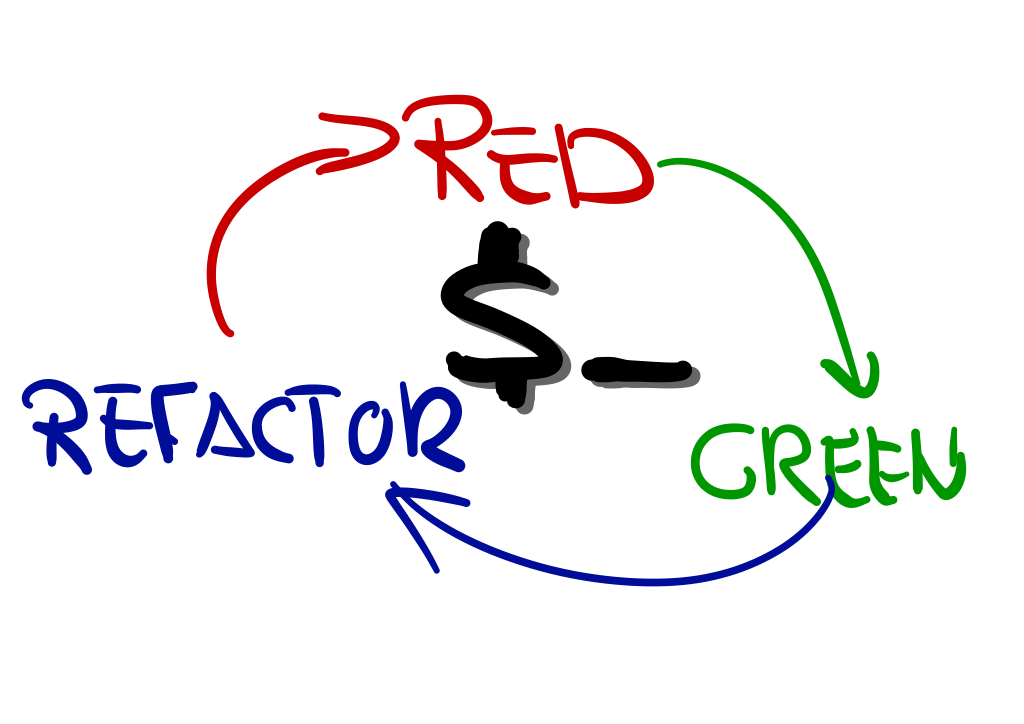
liveblog: the accidental sysadmin (starting at 28 minutes into the session)
Read More
A live blog of Mary Poppendieck’s xp2016 keynote.
Read More
Elizabeth Hendrickson keynoting on eXtreme programming at scale, XP2016 Edinburgh. Elizabeth works as VP R&D for Cloud foundry development at Pivotal.
Read More
This is the second part of my writeup of the session I did at XPDays Benelux and XP 2016 in Edinburgh called “Bourne Again” on bootstrapping a unit testing framework in the Bourne Again Shell (bash). This series of posts walk you through the steps I took in 75 minutes of programming.
Read More
I did a public programming session at XPDays Benelux and XP 2016 in Edinburgh called “Bourne Again” on bootstrapping a unit testing framework in the Bourne Again Shell (bash). This series of posts walk you through the steps I took in 75 minutes of programming.
Read MoreWe strive for simple code. It is something we pay attention to in the Refactoring step of the Test Driven Development cycle. But what is “simple”? How do we stay away from discussions about taste or “simplicity is in the eye of the beholder?”.
Read More
Sallyann Freudenberg once asked how do developers communicate during pair programming. Do you talk, draw, or let the code or tests talk?
Read More
When you are changing an interface or API that is widely used, it can be tempting to do the change in one go and break a lot of tests at once, assuming you can just fix them. You risk ending up chasing failing tests around for hours, with lack of good feedback why they fail. Furthermore, you risk breaking something along the way, because you have created holes in your safety net!
Read More
Read MoreA heuristic is anything that provides a plausible aid or direction in the solution of a problem but is in the final analysis unjustified, incapable of justification, and potentially fallible.

As we spend more time reading code than writing it, we’d like our code to be glanceable. By glancing at the code, we want to quickly understand its intent. Glanceability is a useful property, for production code as well as test code. Test code is there to help us out, so being able to quickly grasp what the test is about will help future us, and others, keep our tests habitable.
Read More
How do I structure my tests, so that they are understandable and focused on the behaviour of the system under test? Given-When-Then and Arrange-Act-Assert are two similar ways of structuring your test cases to make them easier to understand at a glance. This test structure also helps to keep your test focused on a single concern.
Read More
We do not like long test scenarios with loads of different asserts. A test case that has many expectations is difficult to understand when it fails. We then have to dig inside the test’s implementation to see what exactly went wrong where. Before we know it, we fall in to a lengthy debugging session.
Read More
We use test names or test descriptions to tell what the test is about: what is the action or event, what is the expected result.
Read More
Once we have a failing test, how do we get to green quickly? If we can get away with faking it, we do that. It is sometimes the simplest way to get the test to pass, and to remind us to write the next test case.
Read More
When we have written a failing test, we try to make it work in the simplest possible way - do the simplest thing that could possibly work. We prefer baby steps, so at each step we understand precisely what we are doing, even if we have not solved the whole problem yet. Cheating and faking are allowed.
Read More
Where do we start when test-driving a new piece of code? All options are open, but we risk getting stuck because of the blank-piece-of-paper feeling. Because we want to take baby steps towards the end result, use the 0, 1, N guideline: we start with some ‘zero’ or edge case, then make it work for a single case, then generalize it to multiple cases.
Read More
Write the last part of your test first: start with the expectation (or the assert) and write the test bottom-up.
Read More
Write a test based on how you wish the object under test could be used. Then make it work. Don’t let yourself be limited by constraints and implementation details… nothing is holding you back! Just write it as you’d wish it to be.
Read More
When writing a test, we don’t just think about how to formulate the test. We think about design - the design of the code-under-test and the context in which it fits. Writing a test is an act of design.
Read More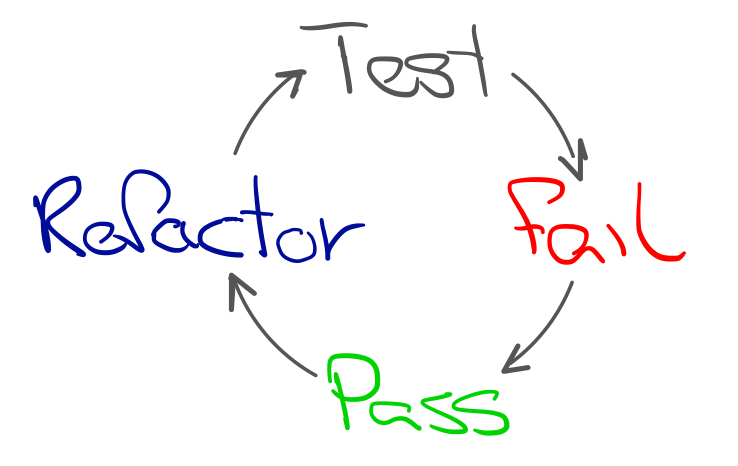
The practice of Test Driven Development (TDD) has been around for quite a few years. It was popularized as part of eXtreme Programming 20 years ago. It has been our favourite way of working ever since, helping us to deliver multiple software products successfully. Though it’s simple to explain, it needs practice to master and to reap its benefits.
Read More
Hexagonal Architecture allows us to continuously evolve a web back-end. In this post, we’ll show you how we do that. It is a continuation of a series, previous instalments demonstrated how Hexagonal architecture facilitates automated test architecture, and development of a Vue.js based front-end. In this post, we will share how we applied it in the back-end for the Online Agile Fluency Diagnostic application.
Read More
We are fans of Test Driven Development (TDD). It has served us well over the years. The TDD cycle - test, fail, run, refactor - is all about getting rich feedback fast, feedback about design decisions, about the test, about your code. We thrive on fast tests. We also want to test-drive our adapter integration and UI tests. These tend to be slow and fragile with low quality feedback, so we try to keep these minimal.
Read More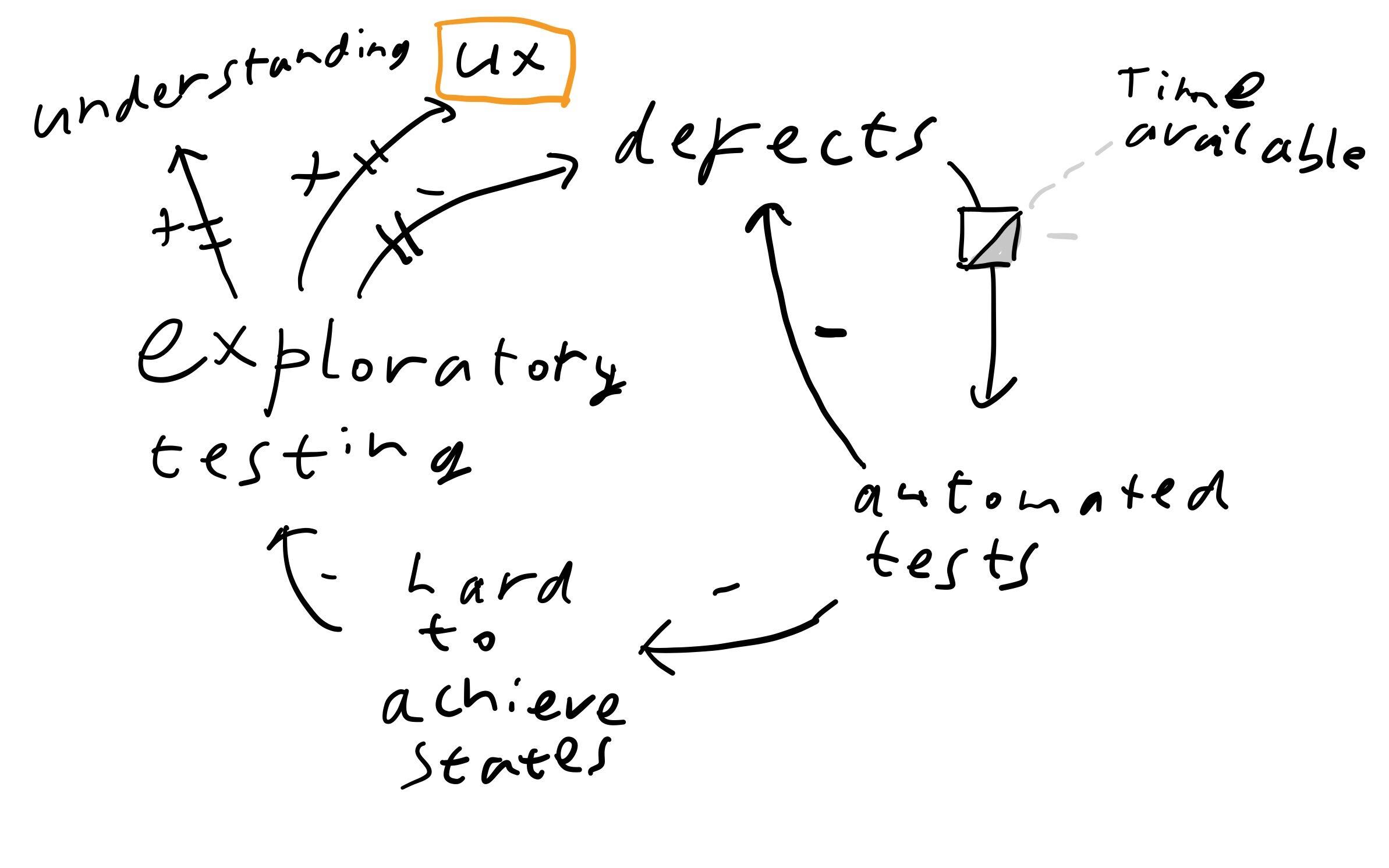
Imagine your UI and end-to-end tests could run an order of magnitude faster than they are now? Oh, you don’t have end-to-end tests, because they would be too slow and brittle? I have had that too, don’t worry. Imagine then if you could have cost-effective end-to-end tests. How would that impact your product development?
Read More
Updated 25-05-2021 - added link to the original Test Builder pattern post by Nat Pryce
Read More
Testing a command line interface (CLI) should be just like testing a REST interface. A CLI is an adapter concern that we can test drive, separate from the business logic. In this post I’ll show an approach to test drive the command line interface of an application in Python.
Read More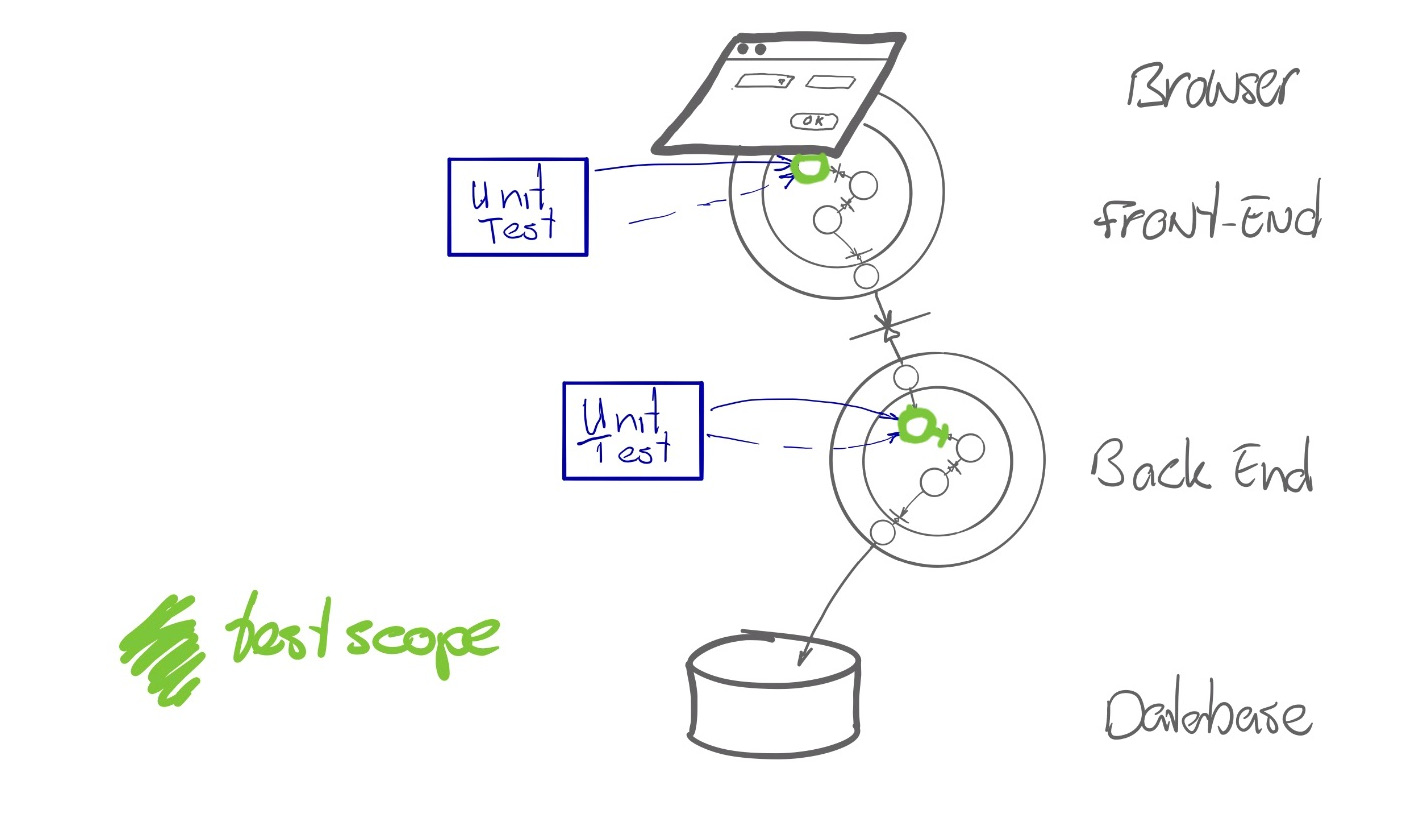
In this post, we will share another benefit of looking through the Hexagonal Architecture lens: it supports making decisions about the architecture of automated tests in your application landscape. It can guide you in questions like:
Read More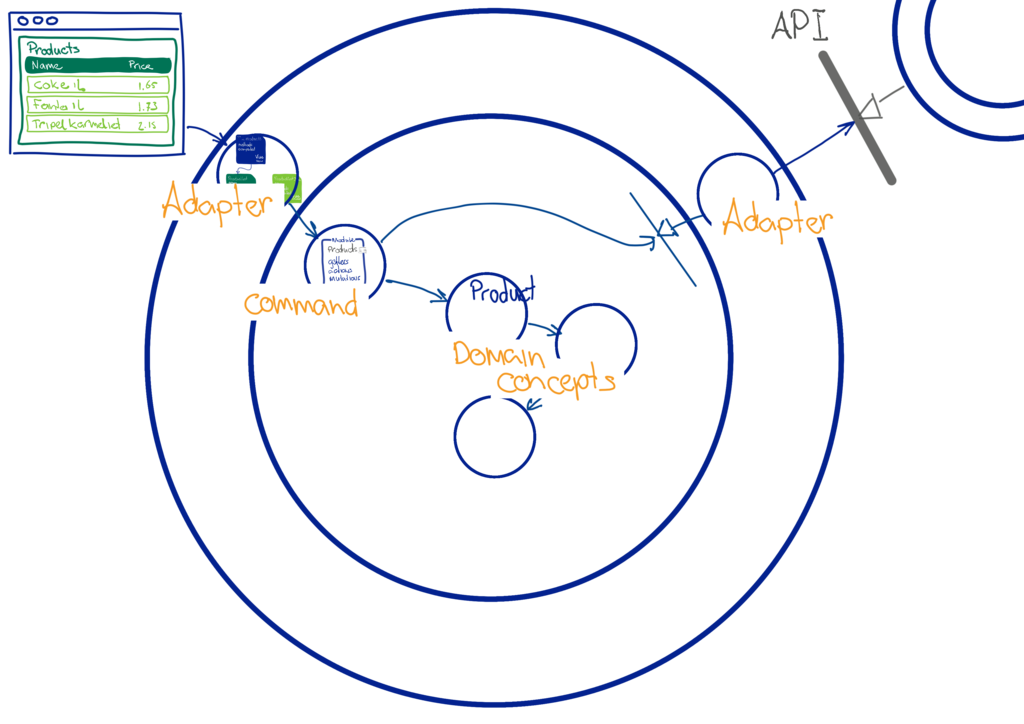
Over the years, we have done our share of UI and front end development. Long long time ago with SmallTalk, Visual Basic and Delphi, building web applications with server side rendering and React, and being involved in Angular projects at several clients. Recently we have been building front ends based on Vue.js. In a series of blog posts, we are going to share how we approach (hexagonal) architecture, test driven development, and incremental design in the front end.
Read More
Happy new year! We are restarting open enrollment courses this year. The first one up is our test driven Java course. This will take place in Utrecht, Netherlands in March 19 and 20 in 2020.
Read MoreDo you have pending tests left over from yesterday? Better delete them before they grow stale.
Read More
This is the second part of my writeup of the session I did at XPDays Benelux and XP 2016 in Edinburgh called “Bourne Again” on bootstrapping a unit testing framework in the Bourne Again Shell (bash). This series of posts walk you through the steps I took in 75 minutes of programming.
Read More
I did a public programming session at XPDays Benelux and XP 2016 in Edinburgh called “Bourne Again” on bootstrapping a unit testing framework in the Bourne Again Shell (bash). This series of posts walk you through the steps I took in 75 minutes of programming.
Read More
In this post, we will reflect on the practice of using feature toggles. As more and more development organizations are moving towards continuous delivery, we see them using feature toggles more and more. It is, once again, not a best practice, but one that comes with trade-offs. We are not implying feature toggles are bad, but we urge you to be aware of the trade-offs and risks involved, and to take a critical look at how you are using them.
Read More
So you want to quickly deploy a small experiment to production. How do you do that? Dokku is one way of doing that. Here are my first impressions.
Read More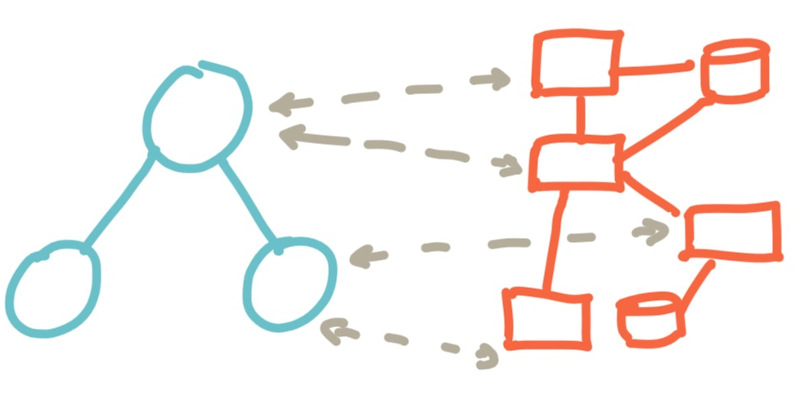
When we visit clients and discuss the architecture of their software systems, we often notice that people conflate different concerns under the term ‘architecture’. They tend to mix logical concerns with deployment concerns. Examples of logical concerns would be domain logic, domain dynamics, and how these are connected. Deployment concerns can be for instance REST APIs, components, microservices, and lambdas. The recent ‘cloud native’ movement has made this even worse, especially with serverless infrastructure concepts.
Read More
Upaated 21 november 2020, added some more notes on Simon Wardleys segment.
Read More
liveblog: the accidental sysadmin (starting at 28 minutes into the session)
Read MoreWe strive for simple code. It is something we pay attention to in the Refactoring step of the Test Driven Development cycle. But what is “simple”? How do we stay away from discussions about taste or “simplicity is in the eye of the beholder?”.
Read More
As we spend more time reading code than writing it, we’d like our code to be glanceable. By glancing at the code, we want to quickly understand its intent. Glanceability is a useful property, for production code as well as test code. Test code is there to help us out, so being able to quickly grasp what the test is about will help future us, and others, keep our tests habitable.
Read More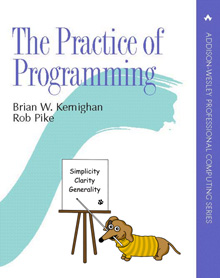
Jez Higgins and Chris Oldwood recommended The Practice of Programming book to me when we were working on an enterprise C++ project. It is from the same vintage as Extreme Programming Explained and Refactoring, but quite different. It is multi-language, but some of the exercises are in C (not surprising, given the authors’ backgrounds). I got started on it last year, but life got in the way, and I needed to practice my C a bit before being able to do anything meaningful in it. Now that Rob and I are prepping for a C++ TDD / Legacy code training next month, I’m in the right frame of mind to also dive deeper into C.

Red-Green-Refactor is broken, because the psychological reward happens at green. When you get that reward, you feel the task has been completed, and are inclined to stop. Therefore refactoring is a lot rarer than it should be.
Read MoreDo you have pending tests left over from yesterday? Better delete them before they grow stale.
Read More
Jez Higgins and Chris Oldwood recommended The Practice of Programming book to me when we were working on an enterprise C++ project. It is from the same vintage as Extreme Programming Explained and Refactoring, but quite different. It is multi-language, but some of the exercises are in C (not surprising, given the authors’ backgrounds). I got started on it last year, but life got in the way, and I needed to practice my C a bit before being able to do anything meaningful in it. Now that Rob and I are prepping for a C++ TDD / Legacy code training next month, I’m in the right frame of mind to also dive deeper into C.
Do you have pending tests left over from yesterday? Better delete them before they grow stale.
Read MoreWe strive for simple code. It is something we pay attention to in the Refactoring step of the Test Driven Development cycle. But what is “simple”? How do we stay away from discussions about taste or “simplicity is in the eye of the beholder?”.
Read More
Working as a consultant, facilitator and coach has taught me the subtle art of not intervening. However simple non-intervening sounds, it is quite difficult to put into practice.
Read More
Marc and Rob are running a workshop on warmups at XP Days Benelux. It is a workshop to share the ways we warm up for practice. This is what I learnt from drawing warmups.
Read More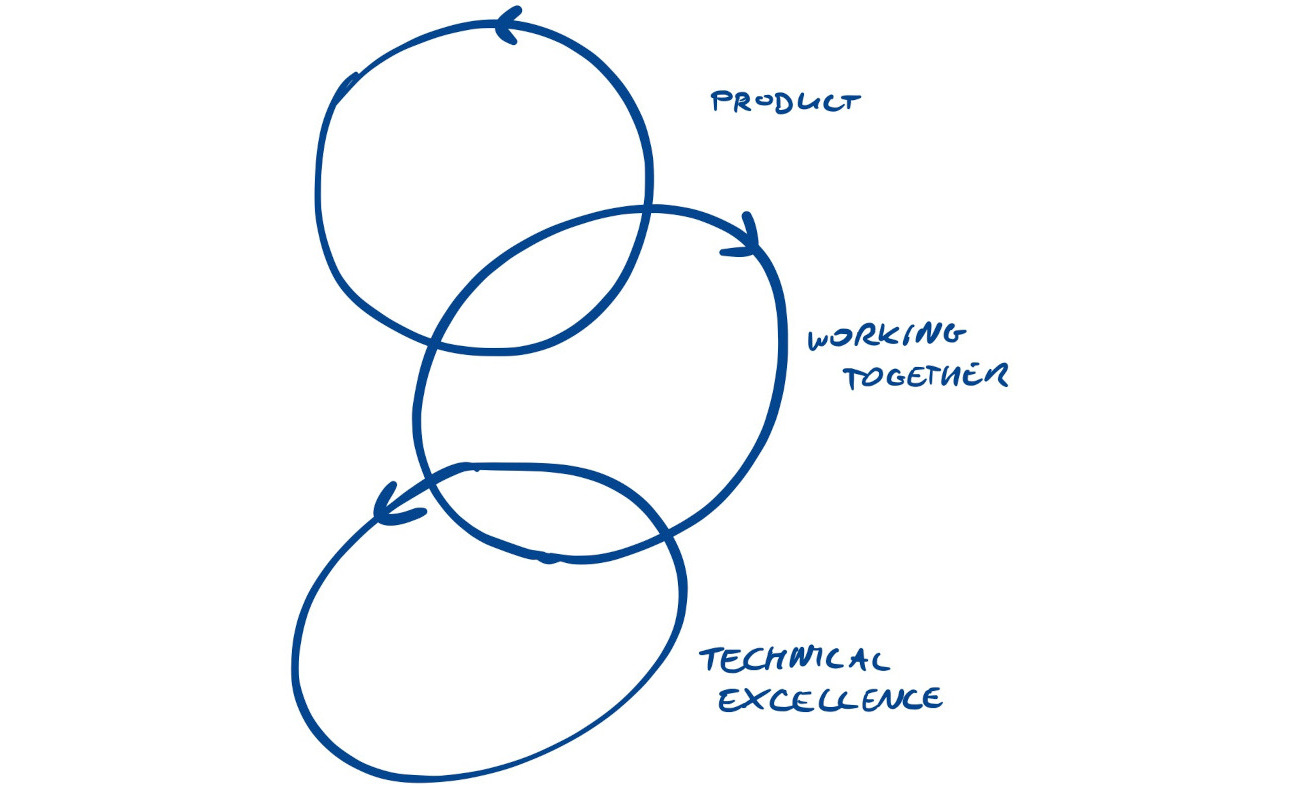
Where to focus improvement efforts in an organisation is difficult, especially with software and multiple stakeholders. Should we bet the house on technical excellence? Let's look at it through three different feedback loops, to see if we are focusing on the 'right' stuff.
Read MoreProductivity of software development teams is difficult to get a grip on, but virtually everyone wants teams to be more productive. We often talk to managers, who say they’d like their teams to be more productive, or in their words ‘go faster’. Today we write a bit more about what we see around productivity in software development, and how seeing productivity as a property of a system can help you spot symptoms, fire-fighting and work towards more durable solutions.
Read More
“We have no time to improve” is something we hear regularly. Our knee jerk response is the old dutch proverb:
You don’t have time, you make time.
In our experience, improvements pay off faster than people believe, so it is worth making time to improve. See how we use flow distribution to make this visible.
Read More
When you are changing an interface or API that is widely used, it can be tempting to do the change in one go and break a lot of tests at once, assuming you can just fix them. You risk ending up chasing failing tests around for hours, with lack of good feedback why they fail. Furthermore, you risk breaking something along the way, because you have created holes in your safety net!
Read More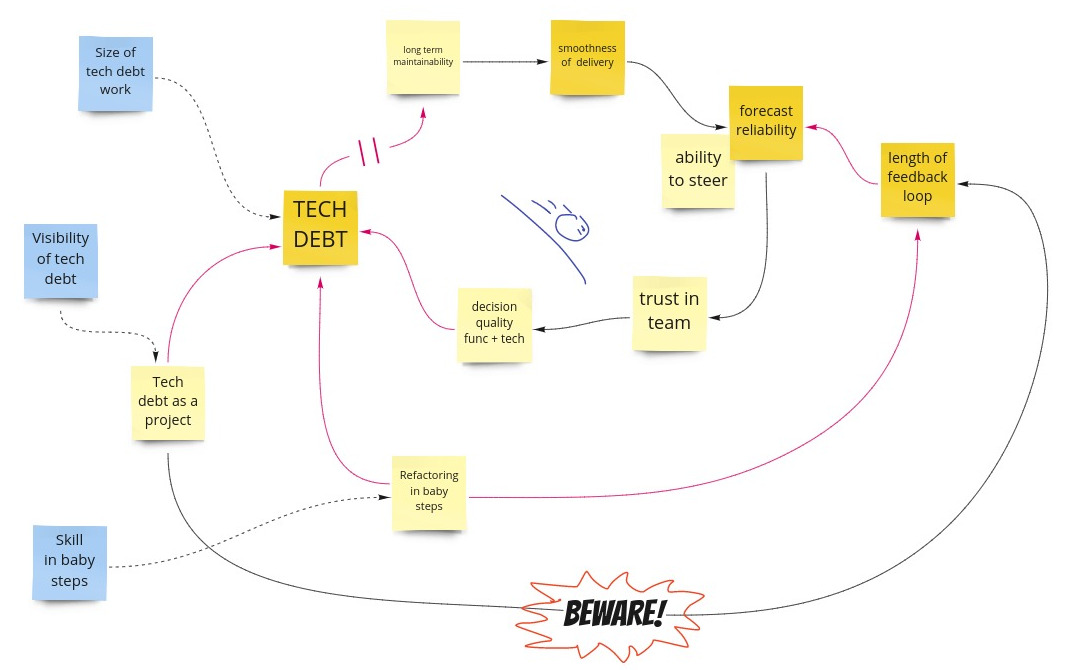
To get better insights in how a team can grow and what support they need from their organization, we use the Agile Fluency® model and associated tools. In this post, we’ll share how we run an Agile Fluency team diagnostic workshop and how we use systems thinking techniques to arrive at recommendations for both the team and management.
Read More
Read MoreA heuristic is anything that provides a plausible aid or direction in the solution of a problem but is in the final analysis unjustified, incapable of justification, and potentially fallible.

As we spend more time reading code than writing it, we’d like our code to be glanceable. By glancing at the code, we want to quickly understand its intent. Glanceability is a useful property, for production code as well as test code. Test code is there to help us out, so being able to quickly grasp what the test is about will help future us, and others, keep our tests habitable.
Read More
How do I structure my tests, so that they are understandable and focused on the behaviour of the system under test? Given-When-Then and Arrange-Act-Assert are two similar ways of structuring your test cases to make them easier to understand at a glance. This test structure also helps to keep your test focused on a single concern.
Read More
We do not like long test scenarios with loads of different asserts. A test case that has many expectations is difficult to understand when it fails. We then have to dig inside the test’s implementation to see what exactly went wrong where. Before we know it, we fall in to a lengthy debugging session.
Read More
We use test names or test descriptions to tell what the test is about: what is the action or event, what is the expected result.
Read More
Once we have a failing test, how do we get to green quickly? If we can get away with faking it, we do that. It is sometimes the simplest way to get the test to pass, and to remind us to write the next test case.
Read More
When we have written a failing test, we try to make it work in the simplest possible way - do the simplest thing that could possibly work. We prefer baby steps, so at each step we understand precisely what we are doing, even if we have not solved the whole problem yet. Cheating and faking are allowed.
Read More
Where do we start when test-driving a new piece of code? All options are open, but we risk getting stuck because of the blank-piece-of-paper feeling. Because we want to take baby steps towards the end result, use the 0, 1, N guideline: we start with some ‘zero’ or edge case, then make it work for a single case, then generalize it to multiple cases.
Read More
Today we’re writing about how simple acts improve feedback loops, which has a compounding effect in development teams over time.
Read More
Write the last part of your test first: start with the expectation (or the assert) and write the test bottom-up.
Read More
Write a test based on how you wish the object under test could be used. Then make it work. Don’t let yourself be limited by constraints and implementation details… nothing is holding you back! Just write it as you’d wish it to be.
Read More
When writing a test, we don’t just think about how to formulate the test. We think about design - the design of the code-under-test and the context in which it fits. Writing a test is an act of design.
Read More
The practice of Test Driven Development (TDD) has been around for quite a few years. It was popularized as part of eXtreme Programming 20 years ago. It has been our favourite way of working ever since, helping us to deliver multiple software products successfully. Though it’s simple to explain, it needs practice to master and to reap its benefits.
Read More
In this post, we will reflect on the practice of using feature toggles. As more and more development organizations are moving towards continuous delivery, we see them using feature toggles more and more. It is, once again, not a best practice, but one that comes with trade-offs. We are not implying feature toggles are bad, but we urge you to be aware of the trade-offs and risks involved, and to take a critical look at how you are using them.
Read More
Red-Green-Refactor is broken, because the psychological reward happens at green. When you get that reward, you feel the task has been completed, and are inclined to stop. Therefore refactoring is a lot rarer than it should be.
Read More
Hot reloading a Halogen app with Parcel requires almost no configuration. Demo
Read More
To remind myself that I often find it easier to encourage others to change than to change myself, I have been using change is for other people as a mantra,
Read More
I was planning to use my keys left for something different today, but found myself in an associative storm of tweets, possible conference sessions to be proposed and some situated software I’ve been working on for a few years, intermittently.
Read More
For a production application I’m using PUX, a purescript wrapper around React. In the way we use it for WeReview we are experiencing performance and usability issues, beyond the slow rendering.
Read More
Hot reloading a Halogen app with Parcel requires almost no configuration. Demo
Read More
Hot reloading a Halogen app with Parcel requires almost no configuration. Demo
Read More
Hot reloading a Halogen app with Parcel requires almost no configuration. Demo
Read More
Red-Green-Refactor is broken, because the psychological reward happens at green. When you get that reward, you feel the task has been completed, and are inclined to stop. Therefore refactoring is a lot rarer than it should be.
Read More
Red-Green-Refactor is broken, because the psychological reward happens at green. When you get that reward, you feel the task has been completed, and are inclined to stop. Therefore refactoring is a lot rarer than it should be.
Read More
To remind myself that I often find it easier to encourage others to change than to change myself, I have been using change is for other people as a mantra,
Read More
I was planning to use my keys left for something different today, but found myself in an associative storm of tweets, possible conference sessions to be proposed and some situated software I’ve been working on for a few years, intermittently.
Read More
For a production application I’m using PUX, a purescript wrapper around React. In the way we use it for WeReview we are experiencing performance and usability issues, beyond the slow rendering.
Read MoreYesterday I thought I pushed out another iteration of our attempt at making the QWAN website more accessible. Turns out I didn’t. While adjusting details, reading CSS and accessibility documentation and blogposts, I missed the fact that the shiny assets pipeline I added does not actually build on github.
Read More
The QWAN site currently is not accessible for blind users. If you were to use a screen reader, the page might just as well be blank. A blind colleague mentioned to us a while ago that they could not read the home page at all. I have just started improving it.
Read More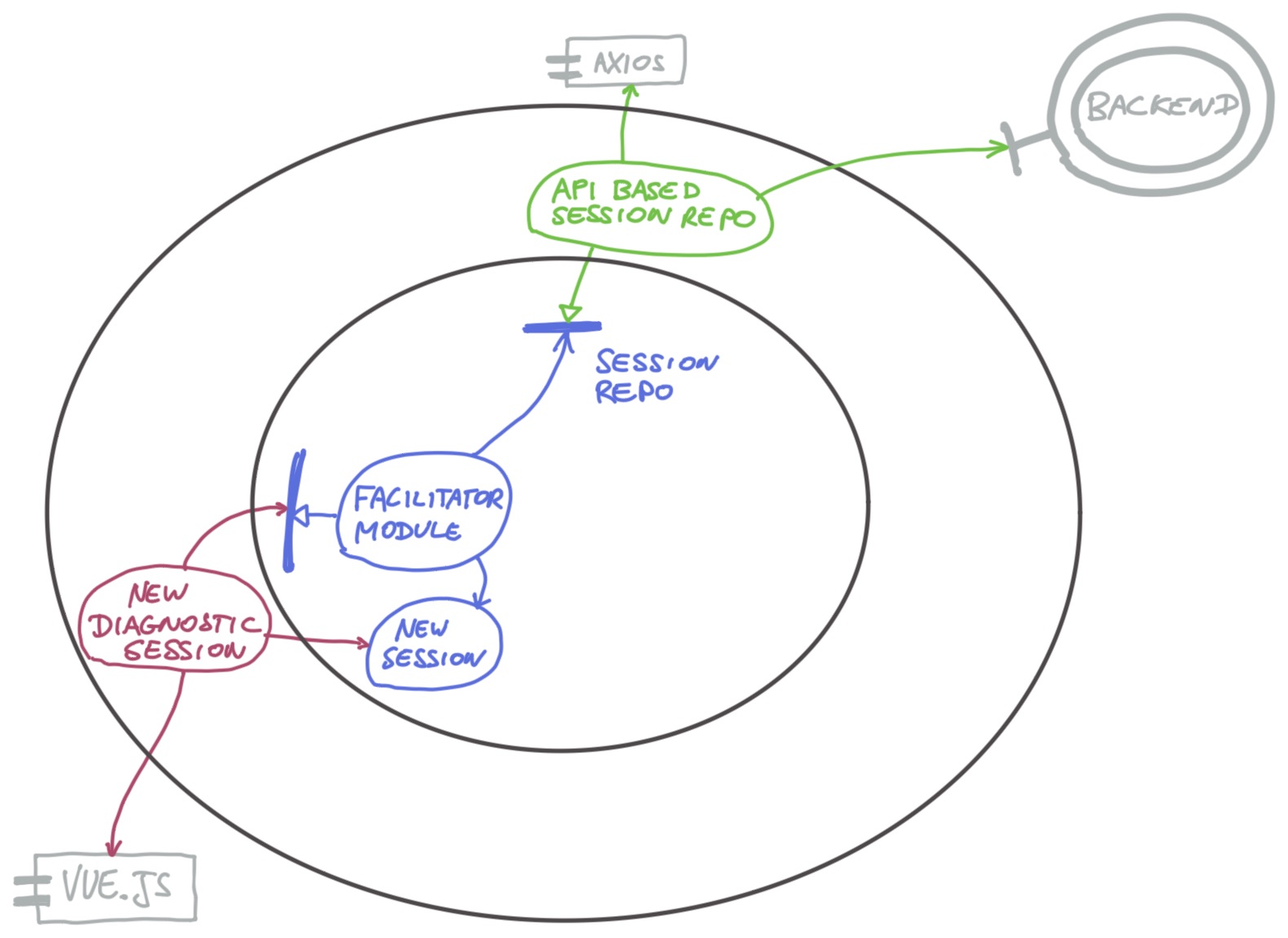
In a previous post, we elaborated on why and how we apply Hexagonal Architecture in front end applications.
Read More
Front ends tend to start out simple, often as ‘just’ a form or a grid showing data that comes from a backend. It looks like ‘just’ a visual layer on top of backend APIs. When a front end evolves and grows, it inevitably becomes more complex. We then need to take a good hard look at the UX/UI and overall architecture.
Read More
Over the years, we have done our share of UI and front end development. Long long time ago with SmallTalk, Visual Basic and Delphi, building web applications with server side rendering and React, and being involved in Angular projects at several clients. Recently we have been building front ends based on Vue.js. In a series of blog posts, we are going to share how we approach (hexagonal) architecture, test driven development, and incremental design in the front end.
Read More
The QWAN site currently is not accessible for blind users. If you were to use a screen reader, the page might just as well be blank. A blind colleague mentioned to us a while ago that they could not read the home page at all. I have just started improving it.
Read More
Why and when do we introduce a new practice? We see a colleague, friend, and/or influencer telling success stories about it. Eager to get the benefits, we start out experimenting and learn how well it is living up to our expectations. We also start seeing other unanticipated effects — distractions, anomalies? Or learning opportunities? In this post we advocate for embracing unintended consequences.
Read More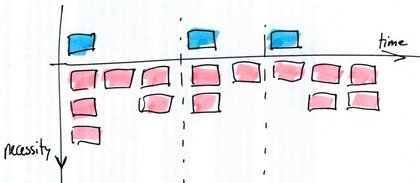
User Story Mapping is one of our favourite practices that we often use with clients and in courses. User Story Mapping is an agile product planning practice, with its roots in user centered design. It has been popularized by Jeff Patton.
Read More
People try something in their team, it works great, and then they go out in the world trying to sell everyone on that practice. We’ve done this too when eXtreme Programming worked much better for us than expected in the early 2000s. When such a “best practice” goes out in the wild, it will work for some, but less so for others. So we end up with “Why you should do Test Driven Development (TDD)” versus “TDD does not work” positions.
Read More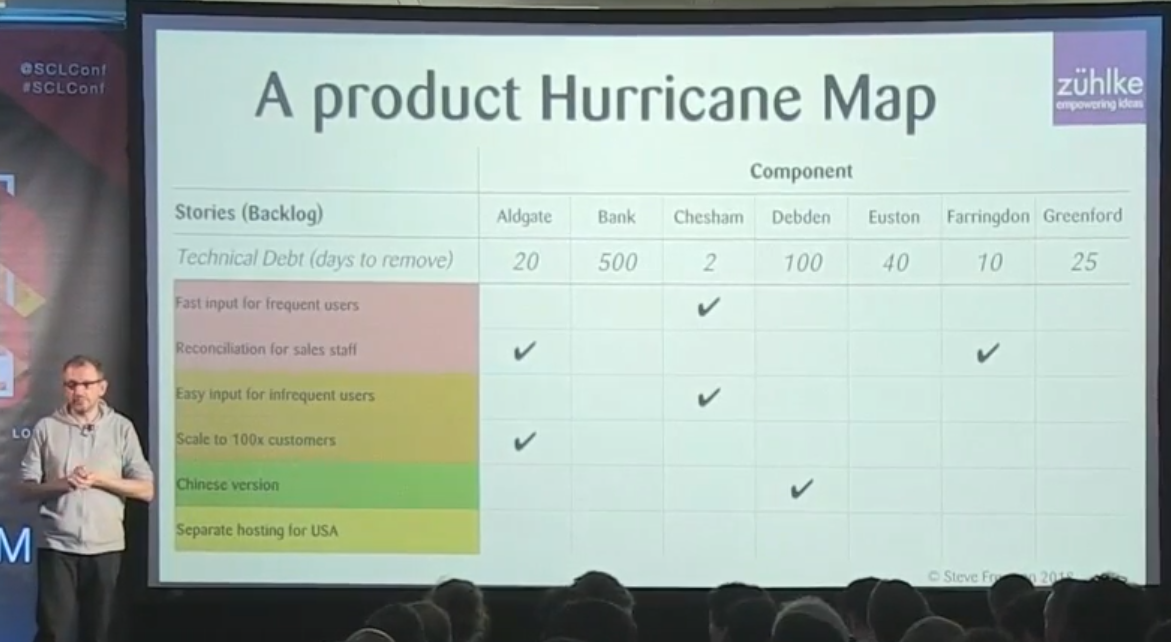
Recently we got asked: “How do we (as a development team or larger group) ‘sell’ technical debt to stakeholders?”
Read MoreRead MoreBeing alive
The search which we make for this quality, in our own lives, is the central search of any person, and the crux of any individual person’s story. It is the search for those moments and situations when we are most alive.
– The Timeless Way of Building, p. 41

I was wondering if Lean Agile Exchange on 10 and 11 September would be as much a Community of Need conference as e.g. Lean Agile Scotland or Agile Cambridge were. I was not disappointed.
Read More
We are sponsoring the Lean Agile Exchange Conference happening online, 10 and 11 September (UK daytime).
Read More
Marc and Rob are running a Hexagonal Architecture workshop this thursday at XP Days Benelux, tickets for XP Days have sold out, but apparently there is a waitlist. So who knows, you still might be able to get a ticket.
Read More
Rob and I participated in the brand new Agile Camp NL conference, a open-space-y conference on agile. Kudos to Karlijn Moll & Thomas van Zuijlen for running the conference and creating such a nice atmosphere!
Read More
I am running a session at the Swindon Developers meetup this Thursday at 6:30PM *. There are still some places available, so join me and register now. In this session I will demonstrate how we make better decisions by making results of work visible through tools that we built for the questions we have. The title evolved from a discussion with the organiser, Sean Moir.
Read More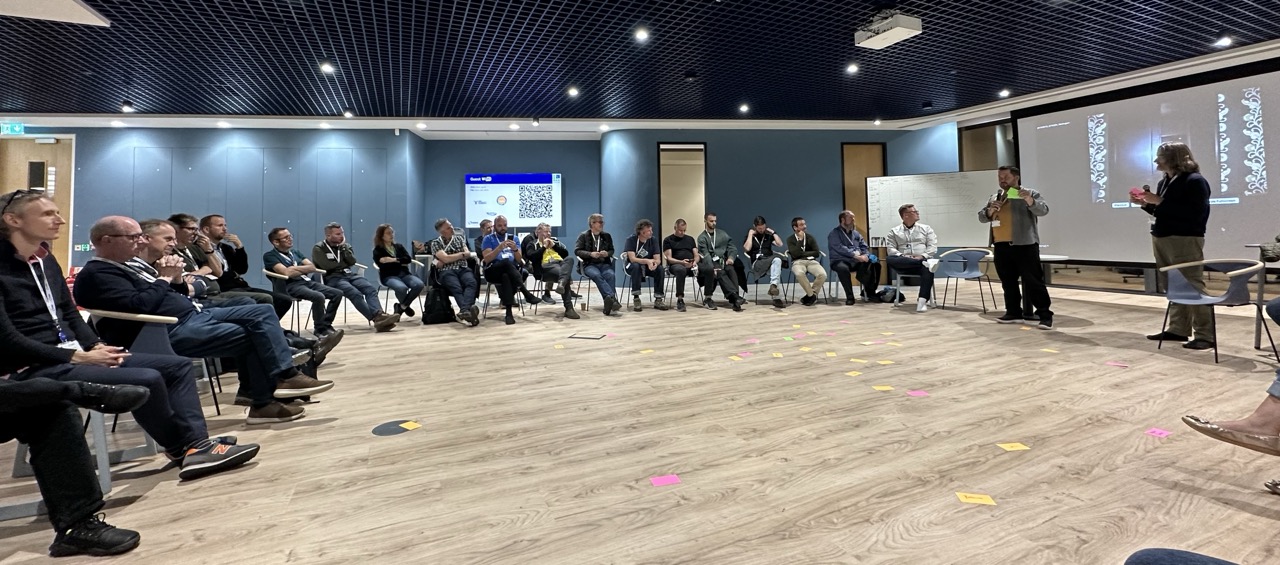
I made a last minute-ish decision to attend CITCON Friday night and Saturday. I don’t normally attend conferences on the weekend, as I prefer to spend time with family. But this was in my neck of the woods - it was in Woking, my side of London - only about 2 hr drive from Bath. And I thought it would be fun to see some people in real life, and possibly learn something. Since it is an open space conference, there is a fair chance that interesting topics turn up, in sessions and outside. I was not disappointed, to say the least. I also got a chance to run a zeroth session on Moldable Development.
Read More
I went to Agile Manchester 2023 because I have a lot of things to think about. And sometimes the best way to think is to have a conversation with someone. At QWAN we like our rubber ducks to talk to, but actual people add that little extra.
Read More
I was wondering if Lean Agile Exchange on 10 and 11 September would be as much a Community of Need conference as e.g. Lean Agile Scotland or Agile Cambridge were. I was not disappointed.
Read More
Marc and Rob are running a Hexagonal Architecture workshop this thursday at XP Days Benelux, tickets for XP Days have sold out, but apparently there is a waitlist. So who knows, you still might be able to get a ticket.
Read More
Rob and I participated in the brand new Agile Camp NL conference, a open-space-y conference on agile. Kudos to Karlijn Moll & Thomas van Zuijlen for running the conference and creating such a nice atmosphere!
Read MoreRead MoreBeing alive
The search which we make for this quality, in our own lives, is the central search of any person, and the crux of any individual person’s story. It is the search for those moments and situations when we are most alive.
– The Timeless Way of Building, p. 41

You are happily applying the Hexagonal Architecture pattern. You have hidden the unpredictable outside world behind ports and adapters, so you can speak your domain language. Awesome! But now your domain model grows as well. How do you keep that understandable? Imagine the inside of your hexagon was a cake. How would you slice your domain?
Read More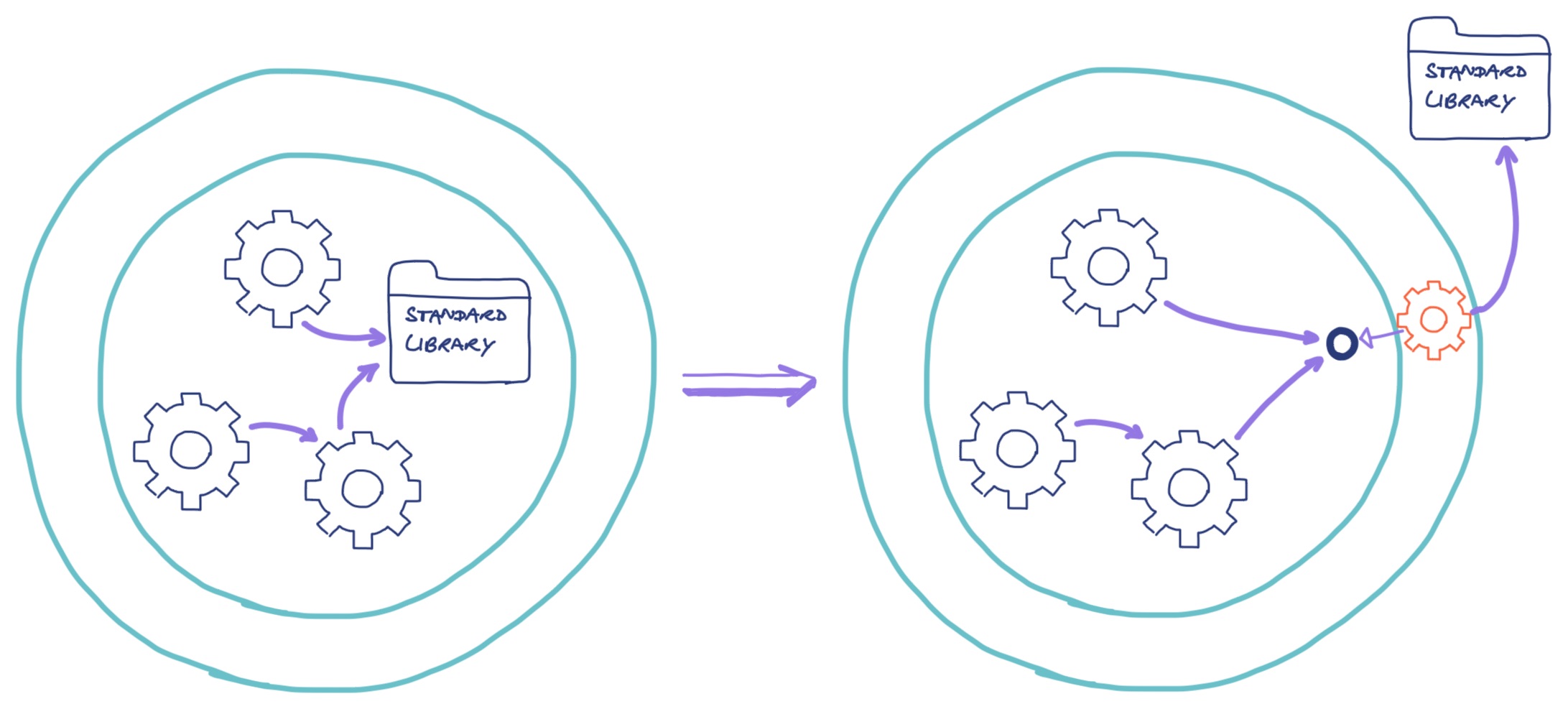
In our previous post on Hexagonal Architecture in a back-end, we mentioned wrapping ID generation and timestamps in concepts of their own. This might feel a bit over-designed, but we have reasons to do so. In this post, we share the trade-offs and rationale behind wrapping the standard stuff in abstractions of your own.
Read More
Hexagonal Architecture allows us to continuously evolve a web back-end. In this post, we’ll show you how we do that. It is a continuation of a series, previous instalments demonstrated how Hexagonal architecture facilitates automated test architecture, and development of a Vue.js based front-end. In this post, we will share how we applied it in the back-end for the Online Agile Fluency Diagnostic application.
Read More
Deciding What To Put Where is half of the work of software development. What should I put where, in such a way that me and my colleagues will be able to find it back later? Finding a good place for things in code greatly helps or hinders maintainability of the code later on.
Read More
So you want to quickly deploy a small experiment to production. How do you do that? Dokku is one way of doing that. Here are my first impressions.
Read More
Imagine your UI and end-to-end tests could run an order of magnitude faster than they are now? Oh, you don’t have end-to-end tests, because they would be too slow and brittle? I have had that too, don’t worry. Imagine then if you could have cost-effective end-to-end tests. How would that impact your product development?
Read More
When we visit clients and discuss the architecture of their software systems, we often notice that people conflate different concerns under the term ‘architecture’. They tend to mix logical concerns with deployment concerns. Examples of logical concerns would be domain logic, domain dynamics, and how these are connected. Deployment concerns can be for instance REST APIs, components, microservices, and lambdas. The recent ‘cloud native’ movement has made this even worse, especially with serverless infrastructure concepts.
Read More
Testing a command line interface (CLI) should be just like testing a REST interface. A CLI is an adapter concern that we can test drive, separate from the business logic. In this post I’ll show an approach to test drive the command line interface of an application in Python.
Read More
In a previous post, we elaborated on why and how we apply Hexagonal Architecture in front end applications.
Read More
In this post, we will share another benefit of looking through the Hexagonal Architecture lens: it supports making decisions about the architecture of automated tests in your application landscape. It can guide you in questions like:
Read More
Front ends tend to start out simple, often as ‘just’ a form or a grid showing data that comes from a backend. It looks like ‘just’ a visual layer on top of backend APIs. When a front end evolves and grows, it inevitably becomes more complex. We then need to take a good hard look at the UX/UI and overall architecture.
Read More
Over the years, we have done our share of UI and front end development. Long long time ago with SmallTalk, Visual Basic and Delphi, building web applications with server side rendering and React, and being involved in Angular projects at several clients. Recently we have been building front ends based on Vue.js. In a series of blog posts, we are going to share how we approach (hexagonal) architecture, test driven development, and incremental design in the front end.
Read More
Hexagonal Architecture, also known as Ports and Adapters, is getting quite a bit of (well-deserved!) attention recently, especially in the Domain Driven Design community. Hexagonal Architecture is not a new thing: it was originally thought up by Alistair Cockburn (of Agile Manifesto fame) in the 90ies.
Read More
Marc and Rob are running a Hexagonal Architecture workshop this thursday at XP Days Benelux, tickets for XP Days have sold out, but apparently there is a waitlist. So who knows, you still might be able to get a ticket.
Read More
Happy new year! We are restarting open enrollment courses this year. The first one up is our test driven Java course. This will take place in Utrecht, Netherlands in March 19 and 20 in 2020.
Read More
Recently we got asked: “How do we (as a development team or larger group) ‘sell’ technical debt to stakeholders?”
Read More
In this post, we will reflect on the practice of using feature toggles. As more and more development organizations are moving towards continuous delivery, we see them using feature toggles more and more. It is, once again, not a best practice, but one that comes with trade-offs. We are not implying feature toggles are bad, but we urge you to be aware of the trade-offs and risks involved, and to take a critical look at how you are using them.
Read More
We are fans of Test Driven Development (TDD). It has served us well over the years. The TDD cycle - test, fail, run, refactor - is all about getting rich feedback fast, feedback about design decisions, about the test, about your code. We thrive on fast tests. We also want to test-drive our adapter integration and UI tests. These tend to be slow and fragile with low quality feedback, so we try to keep these minimal.
Read More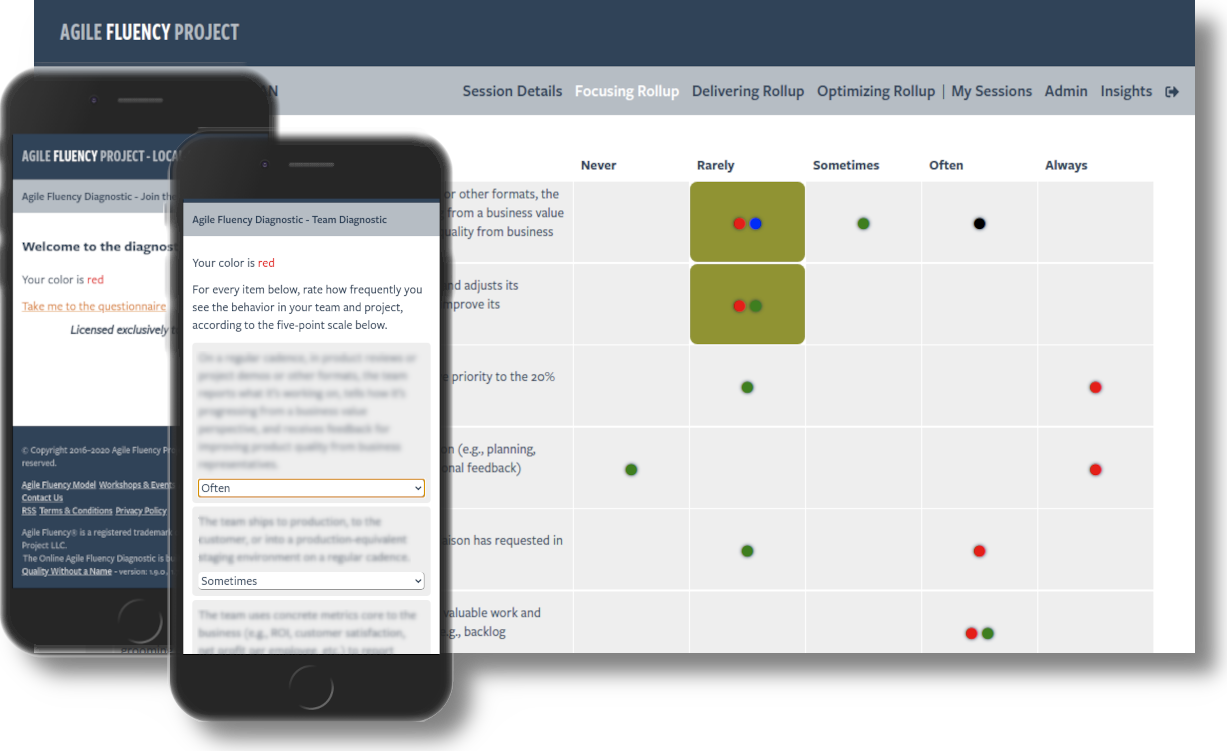
In this next post in our series on Dimensional Planning, we will share how we applied Dimensional Planning to the Online Agile Fluency® Diagnostic application we have been working on since spring.
Read More
In a previous post, we introduced the Dimensional Planning technique, and shared how we used this for a product we worked on. In this post, we will go more in depth and show how you can use the roads metaphor not only for releases of a product, but for individual features as well. This provides a fine-grained mechanism for planning and delivering small, valuable increments.
Read More
So you want to quickly deploy a small experiment to production. How do you do that? Dokku is one way of doing that. Here are my first impressions.
Read More
Are you regularly holding retrospectives, but they do not result in improvements? In this post we will highlight how a team can move to a virtuous cycle of continuous improvement.
Read More
Imagine your UI and end-to-end tests could run an order of magnitude faster than they are now? Oh, you don’t have end-to-end tests, because they would be too slow and brittle? I have had that too, don’t worry. Imagine then if you could have cost-effective end-to-end tests. How would that impact your product development?
Read More
Testing a command line interface (CLI) should be just like testing a REST interface. A CLI is an adapter concern that we can test drive, separate from the business logic. In this post I’ll show an approach to test drive the command line interface of an application in Python.
Read More
In this post, we will explain how Dimensional Planning can work by sharing a story of how we applied it in a project and how it helped us to steer the project towards delivering its desired outcomes in time.
Read More
In this post, we will share another benefit of looking through the Hexagonal Architecture lens: it supports making decisions about the architecture of automated tests in your application landscape. It can guide you in questions like:
Read More
Continuous delivery is valuable, but where do you start? At the start of a greenfield development you have no software, and if you had any software, you would not know how to put it into production.
Read More
Starting new product development with the question ‘What can we leave out?’ may seem paradoxical. We do this to start a conversation between customers and developers. As we go we develop a shared language, so that value can be delivered early and often. This is called Dimensional Planning.
Read MoreYesterday I thought I pushed out another iteration of our attempt at making the QWAN website more accessible. Turns out I didn’t. While adjusting details, reading CSS and accessibility documentation and blogposts, I missed the fact that the shiny assets pipeline I added does not actually build on github.
Read MoreSometimes I think: “this is not enough for a blogpost”; I’ll make a LinkedIn post out of it. But maybe not. As a reader, my feed is like a firehose. For instance, I see a nice write-up from Rob Bowley or Simon Wardley. Then after reading some of the references, coming back to the timeline, the post has moved away 😺.
Read MoreWork has, once again for me, become more personal. I’m getting back into writing. This is a quick, rambling, update, so you can at least get some idea of what we are up to at the moment.
Read More
Marc and Rob are running a workshop on warmups at XP Days Benelux. It is a workshop to share the ways we warm up for practice. This is what I learnt from drawing warmups.
Read MoreWork has, once again for me, become more personal. I’m getting back into writing. This is a quick, rambling, update, so you can at least get some idea of what we are up to at the moment.
Read More
Software delivery is knowledge intensive work. We are continuously learning, about the problems we’re solving, about our users and customers, about how we can work more productively. We are building up knowledge in multiple areas, but we are not always good at keeping knowledge or making most use of it. Take working with legacy code for example, which often feels like a process of archaeology, rediscovering long forgotten knowledge.
Read More
Why and when do we introduce a new practice? We see a colleague, friend, and/or influencer telling success stories about it. Eager to get the benefits, we start out experimenting and learn how well it is living up to our expectations. We also start seeing other unanticipated effects — distractions, anomalies? Or learning opportunities? In this post we advocate for embracing unintended consequences.
Read More
People try something in their team, it works great, and then they go out in the world trying to sell everyone on that practice. We’ve done this too when eXtreme Programming worked much better for us than expected in the early 2000s. When such a “best practice” goes out in the wild, it will work for some, but less so for others. So we end up with “Why you should do Test Driven Development (TDD)” versus “TDD does not work” positions.
Read More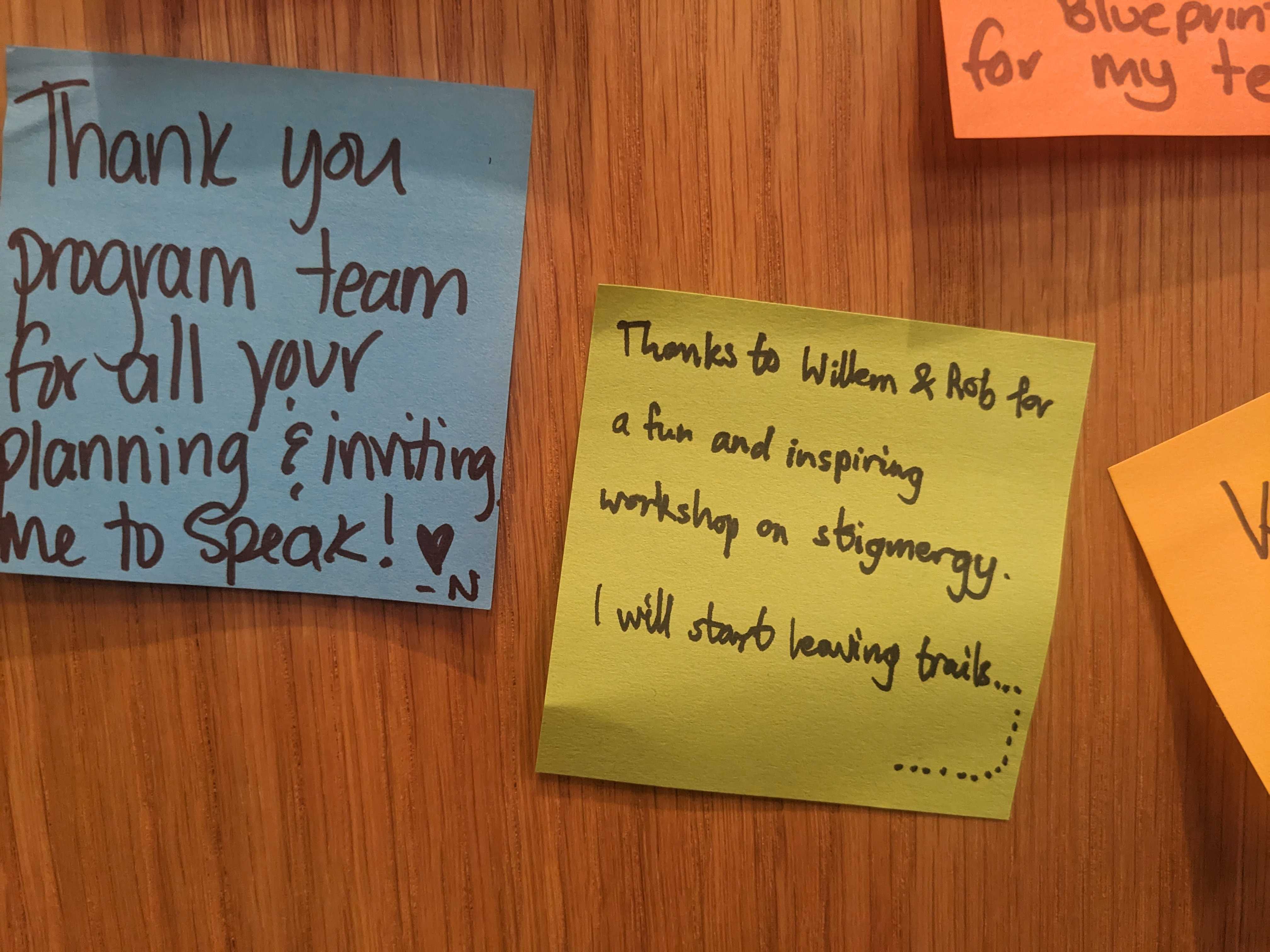
Rob and I ran a workshop at Lean Agile Scotland 2023 on Stigmergy. Two groups thought about how their actions shape their environment, which in turn encourages more actions.
Read More
Recently we got asked: “How do we (as a development team or larger group) ‘sell’ technical debt to stakeholders?”
Read MoreRead MoreBeing alive
The search which we make for this quality, in our own lives, is the central search of any person, and the crux of any individual person’s story. It is the search for those moments and situations when we are most alive.
– The Timeless Way of Building, p. 41

Hexagonal Architecture allows us to continuously evolve a web back-end. In this post, we’ll show you how we do that. It is a continuation of a series, previous instalments demonstrated how Hexagonal architecture facilitates automated test architecture, and development of a Vue.js based front-end. In this post, we will share how we applied it in the back-end for the Online Agile Fluency Diagnostic application.
Read More
Continuous delivery is valuable, but where do you start? At the start of a greenfield development you have no software, and if you had any software, you would not know how to put it into production.
Read More
Over the years, we have done our share of UI and front end development. Long long time ago with SmallTalk, Visual Basic and Delphi, building web applications with server side rendering and React, and being involved in Angular projects at several clients. Recently we have been building front ends based on Vue.js. In a series of blog posts, we are going to share how we approach (hexagonal) architecture, test driven development, and incremental design in the front end.
Read More
Hexagonal Architecture, also known as Ports and Adapters, is getting quite a bit of (well-deserved!) attention recently, especially in the Domain Driven Design community. Hexagonal Architecture is not a new thing: it was originally thought up by Alistair Cockburn (of Agile Manifesto fame) in the 90ies.
Read MoreEven when it doesn’t feel like it.
Read MoreI enjoyed watching Container Solutions’ Jamie Dobson present an introduction to their pattern language for strategy yesterday, titled “A framework for strategy, making decisions in turbulent times”. I recommend viewing the recording, ‘A Pattern Language for Strategy’. Below are my main takeaways.
Read More
Upaated 21 november 2020, added some more notes on Simon Wardleys segment.
Read More
We are sponsoring the Lean Agile Exchange Conference happening online, 10 and 11 September (UK daytime).
Read MoreEven when it doesn’t feel like it.
Read MoreI enjoyed watching Container Solutions’ Jamie Dobson present an introduction to their pattern language for strategy yesterday, titled “A framework for strategy, making decisions in turbulent times”. I recommend viewing the recording, ‘A Pattern Language for Strategy’. Below are my main takeaways.
Read MoreI enjoyed watching Container Solutions’ Jamie Dobson present an introduction to their pattern language for strategy yesterday, titled “A framework for strategy, making decisions in turbulent times”. I recommend viewing the recording, ‘A Pattern Language for Strategy’. Below are my main takeaways.
Read MoreWe strive for simple code. It is something we pay attention to in the Refactoring step of the Test Driven Development cycle. But what is “simple”? How do we stay away from discussions about taste or “simplicity is in the eye of the beholder?”.
Read More
Working as a consultant, facilitator and coach has taught me the subtle art of not intervening. However simple non-intervening sounds, it is quite difficult to put into practice.
Read MoreRob Westgeest and Vera Peeters’ Drawing Carousel workshop has been accepted for XP days benelux. It runs before close on Friday 28 November in Kapellerput, Heeze, NL. QWAN’s sessions are bookending the programme, eXtreme Vibe coding is scheduled in the opening slot on Thursday.
Read More
Where to focus improvement efforts in an organisation is difficult, especially with software and multiple stakeholders. Should we bet the house on technical excellence? Let's look at it through three different feedback loops, to see if we are focusing on the 'right' stuff.
Read MoreProductivity of software development teams is difficult to get a grip on, but virtually everyone wants teams to be more productive. We often talk to managers, who say they’d like their teams to be more productive, or in their words ‘go faster’. Today we write a bit more about what we see around productivity in software development, and how seeing productivity as a property of a system can help you spot symptoms, fire-fighting and work towards more durable solutions.
Read More
“We have no time to improve” is something we hear regularly. Our knee jerk response is the old dutch proverb:
You don’t have time, you make time.
In our experience, improvements pay off faster than people believe, so it is worth making time to improve. See how we use flow distribution to make this visible.
Read More
Today we’re writing about how simple acts improve feedback loops, which has a compounding effect in development teams over time.
Read More
We are fans of Test Driven Development (TDD). It has served us well over the years. The TDD cycle - test, fail, run, refactor - is all about getting rich feedback fast, feedback about design decisions, about the test, about your code. We thrive on fast tests. We also want to test-drive our adapter integration and UI tests. These tend to be slow and fragile with low quality feedback, so we try to keep these minimal.
Read More
Are you regularly holding retrospectives, but they do not result in improvements? In this post we will highlight how a team can move to a virtuous cycle of continuous improvement.
Read MoreEven when it doesn’t feel like it.
Read MoreEven when it doesn’t feel like it.
Read More
I made a last minute-ish decision to attend CITCON Friday night and Saturday. I don’t normally attend conferences on the weekend, as I prefer to spend time with family. But this was in my neck of the woods - it was in Woking, my side of London - only about 2 hr drive from Bath. And I thought it would be fun to see some people in real life, and possibly learn something. Since it is an open space conference, there is a fair chance that interesting topics turn up, in sessions and outside. I was not disappointed, to say the least. I also got a chance to run a zeroth session on Moldable Development.
Read More
Marc and Rob are running a workshop on warmups at XP Days Benelux. It is a workshop to share the ways we warm up for practice. This is what I learnt from drawing warmups.
Read More
Rob and I ran a workshop at Lean Agile Scotland 2023 on Stigmergy. Two groups thought about how their actions shape their environment, which in turn encourages more actions.
Read More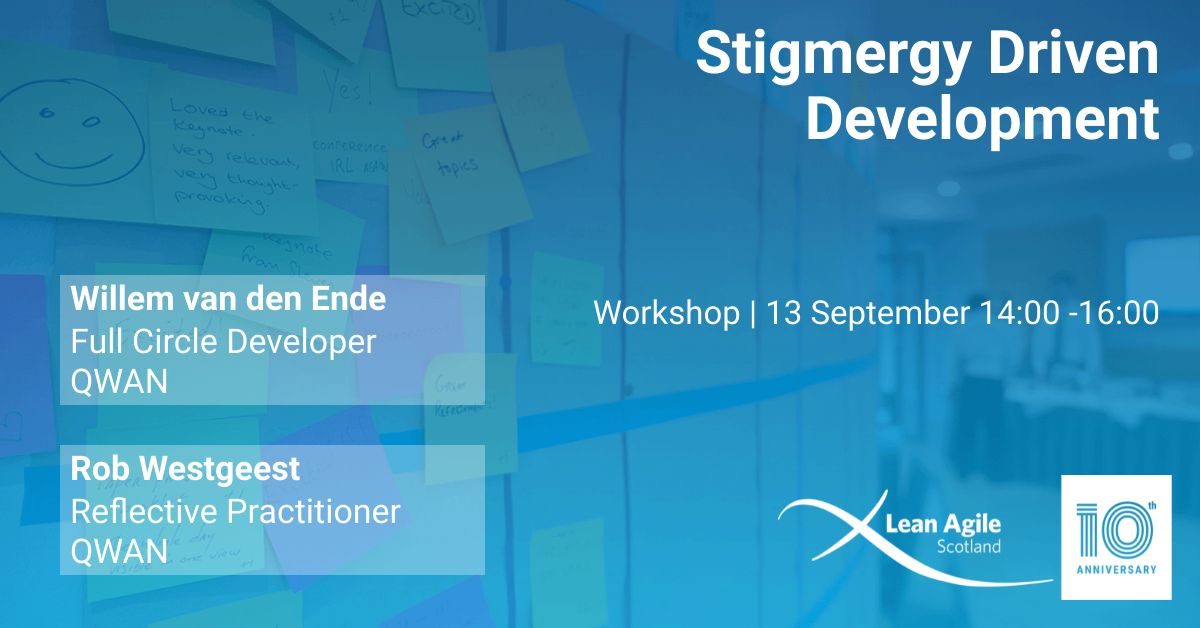
What’s cooking in QWAN’s kitchen - September 2023.
Read More
I went to Agile Manchester 2023 because I have a lot of things to think about. And sometimes the best way to think is to have a conversation with someone. At QWAN we like our rubber ducks to talk to, but actual people add that little extra.
Read More
I was wondering if Lean Agile Exchange on 10 and 11 September would be as much a Community of Need conference as e.g. Lean Agile Scotland or Agile Cambridge were. I was not disappointed.
Read More
We are sponsoring the Lean Agile Exchange Conference happening online, 10 and 11 September (UK daytime).
Read More
“We have no time to improve” is something we hear regularly. Our knee jerk response is the old dutch proverb:
You don’t have time, you make time.
In our experience, improvements pay off faster than people believe, so it is worth making time to improve. See how we use flow distribution to make this visible.
Read More
I was wondering if Lean Agile Exchange on 10 and 11 September would be as much a Community of Need conference as e.g. Lean Agile Scotland or Agile Cambridge were. I was not disappointed.
Read More
We are sponsoring the Lean Agile Exchange Conference happening online, 10 and 11 September (UK daytime).
Read More
You are happily applying the Hexagonal Architecture pattern. You have hidden the unpredictable outside world behind ports and adapters, so you can speak your domain language. Awesome! But now your domain model grows as well. How do you keep that understandable? Imagine the inside of your hexagon was a cake. How would you slice your domain?
Read More
Hexagonal Architecture allows us to continuously evolve a web back-end. In this post, we’ll show you how we do that. It is a continuation of a series, previous instalments demonstrated how Hexagonal architecture facilitates automated test architecture, and development of a Vue.js based front-end. In this post, we will share how we applied it in the back-end for the Online Agile Fluency Diagnostic application.
Read More
In a previous post, we elaborated on why and how we apply Hexagonal Architecture in front end applications.
Read More
In this post, we will share another benefit of looking through the Hexagonal Architecture lens: it supports making decisions about the architecture of automated tests in your application landscape. It can guide you in questions like:
Read More
Front ends tend to start out simple, often as ‘just’ a form or a grid showing data that comes from a backend. It looks like ‘just’ a visual layer on top of backend APIs. When a front end evolves and grows, it inevitably becomes more complex. We then need to take a good hard look at the UX/UI and overall architecture.
Read More
Over the years, we have done our share of UI and front end development. Long long time ago with SmallTalk, Visual Basic and Delphi, building web applications with server side rendering and React, and being involved in Angular projects at several clients. Recently we have been building front ends based on Vue.js. In a series of blog posts, we are going to share how we approach (hexagonal) architecture, test driven development, and incremental design in the front end.
Read More
Hexagonal Architecture, also known as Ports and Adapters, is getting quite a bit of (well-deserved!) attention recently, especially in the Domain Driven Design community. Hexagonal Architecture is not a new thing: it was originally thought up by Alistair Cockburn (of Agile Manifesto fame) in the 90ies.
Read More
Why and when do we introduce a new practice? We see a colleague, friend, and/or influencer telling success stories about it. Eager to get the benefits, we start out experimenting and learn how well it is living up to our expectations. We also start seeing other unanticipated effects — distractions, anomalies? Or learning opportunities? In this post we advocate for embracing unintended consequences.
Read More
People try something in their team, it works great, and then they go out in the world trying to sell everyone on that practice. We’ve done this too when eXtreme Programming worked much better for us than expected in the early 2000s. When such a “best practice” goes out in the wild, it will work for some, but less so for others. So we end up with “Why you should do Test Driven Development (TDD)” versus “TDD does not work” positions.
Read MoreRob Westgeest and Vera Peeters’ Drawing Carousel workshop has been accepted for XP days benelux. It runs before close on Friday 28 November in Kapellerput, Heeze, NL. QWAN’s sessions are bookending the programme, eXtreme Vibe coding is scheduled in the opening slot on Thursday.
Read More
Sallyann Freudenberg once asked how do developers communicate during pair programming. Do you talk, draw, or let the code or tests talk?
Read More
When you are changing an interface or API that is widely used, it can be tempting to do the change in one go and break a lot of tests at once, assuming you can just fix them. You risk ending up chasing failing tests around for hours, with lack of good feedback why they fail. Furthermore, you risk breaking something along the way, because you have created holes in your safety net!
Read More
As we spend more time reading code than writing it, we’d like our code to be glanceable. By glancing at the code, we want to quickly understand its intent. Glanceability is a useful property, for production code as well as test code. Test code is there to help us out, so being able to quickly grasp what the test is about will help future us, and others, keep our tests habitable.
Read More
How do I structure my tests, so that they are understandable and focused on the behaviour of the system under test? Given-When-Then and Arrange-Act-Assert are two similar ways of structuring your test cases to make them easier to understand at a glance. This test structure also helps to keep your test focused on a single concern.
Read More
We do not like long test scenarios with loads of different asserts. A test case that has many expectations is difficult to understand when it fails. We then have to dig inside the test’s implementation to see what exactly went wrong where. Before we know it, we fall in to a lengthy debugging session.
Read More
We use test names or test descriptions to tell what the test is about: what is the action or event, what is the expected result.
Read More
Once we have a failing test, how do we get to green quickly? If we can get away with faking it, we do that. It is sometimes the simplest way to get the test to pass, and to remind us to write the next test case.
Read More
When we have written a failing test, we try to make it work in the simplest possible way - do the simplest thing that could possibly work. We prefer baby steps, so at each step we understand precisely what we are doing, even if we have not solved the whole problem yet. Cheating and faking are allowed.
Read More
Where do we start when test-driving a new piece of code? All options are open, but we risk getting stuck because of the blank-piece-of-paper feeling. Because we want to take baby steps towards the end result, use the 0, 1, N guideline: we start with some ‘zero’ or edge case, then make it work for a single case, then generalize it to multiple cases.
Read More
Write the last part of your test first: start with the expectation (or the assert) and write the test bottom-up.
Read More
Write a test based on how you wish the object under test could be used. Then make it work. Don’t let yourself be limited by constraints and implementation details… nothing is holding you back! Just write it as you’d wish it to be.
Read More
When writing a test, we don’t just think about how to formulate the test. We think about design - the design of the code-under-test and the context in which it fits. Writing a test is an act of design.
Read More
The practice of Test Driven Development (TDD) has been around for quite a few years. It was popularized as part of eXtreme Programming 20 years ago. It has been our favourite way of working ever since, helping us to deliver multiple software products successfully. Though it’s simple to explain, it needs practice to master and to reap its benefits.
Read More
Us three, having fallen into a conversation with code:
Read More
User Story Mapping is one of our favourite practices that we often use with clients and in courses. User Story Mapping is an agile product planning practice, with its roots in user centered design. It has been popularized by Jeff Patton.
Read More
In this next post in our series on Dimensional Planning, we will share how we applied Dimensional Planning to the Online Agile Fluency® Diagnostic application we have been working on since spring.
Read More
In a previous post, we introduced the Dimensional Planning technique, and shared how we used this for a product we worked on. In this post, we will go more in depth and show how you can use the roads metaphor not only for releases of a product, but for individual features as well. This provides a fine-grained mechanism for planning and delivering small, valuable increments.
Read More
In this post, we will explain how Dimensional Planning can work by sharing a story of how we applied it in a project and how it helped us to steer the project towards delivering its desired outcomes in time.
Read More
Starting new product development with the question ‘What can we leave out?’ may seem paradoxical. We do this to start a conversation between customers and developers. As we go we develop a shared language, so that value can be delivered early and often. This is called Dimensional Planning.
Read More
Software delivery is knowledge intensive work. We are continuously learning, about the problems we’re solving, about our users and customers, about how we can work more productively. We are building up knowledge in multiple areas, but we are not always good at keeping knowledge or making most use of it. Take working with legacy code for example, which often feels like a process of archaeology, rediscovering long forgotten knowledge.
Read More
In our previous post on Hexagonal Architecture in a back-end, we mentioned wrapping ID generation and timestamps in concepts of their own. This might feel a bit over-designed, but we have reasons to do so. In this post, we share the trade-offs and rationale behind wrapping the standard stuff in abstractions of your own.
Read More
Deciding What To Put Where is half of the work of software development. What should I put where, in such a way that me and my colleagues will be able to find it back later? Finding a good place for things in code greatly helps or hinders maintainability of the code later on.
Read More
Updated 25-05-2021 - added link to the original Test Builder pattern post by Nat Pryce
Read MoreWe strive for simple code. It is something we pay attention to in the Refactoring step of the Test Driven Development cycle. But what is “simple”? How do we stay away from discussions about taste or “simplicity is in the eye of the beholder?”.
Read More
Working as a consultant, facilitator and coach has taught me the subtle art of not intervening. However simple non-intervening sounds, it is quite difficult to put into practice.
Read More
Software delivery is knowledge intensive work. We are continuously learning, about the problems we’re solving, about our users and customers, about how we can work more productively. We are building up knowledge in multiple areas, but we are not always good at keeping knowledge or making most use of it. Take working with legacy code for example, which often feels like a process of archaeology, rediscovering long forgotten knowledge.
Read More
Why and when do we introduce a new practice? We see a colleague, friend, and/or influencer telling success stories about it. Eager to get the benefits, we start out experimenting and learn how well it is living up to our expectations. We also start seeing other unanticipated effects — distractions, anomalies? Or learning opportunities? In this post we advocate for embracing unintended consequences.
Read More
People try something in their team, it works great, and then they go out in the world trying to sell everyone on that practice. We’ve done this too when eXtreme Programming worked much better for us than expected in the early 2000s. When such a “best practice” goes out in the wild, it will work for some, but less so for others. So we end up with “Why you should do Test Driven Development (TDD)” versus “TDD does not work” positions.
Read More
We found this draft while shuttding down stigmergy.blog. This workshop happened in November 2023. It got stuck in the draft box, because of perfectionism. Stigmergy is something that we take with us as we co-create systems of software and of work, but have not found other conferences or user groups to run the workshop at. A micro site for stigmergy was an experiment, it seems more productive to continue with Stigmergy here.
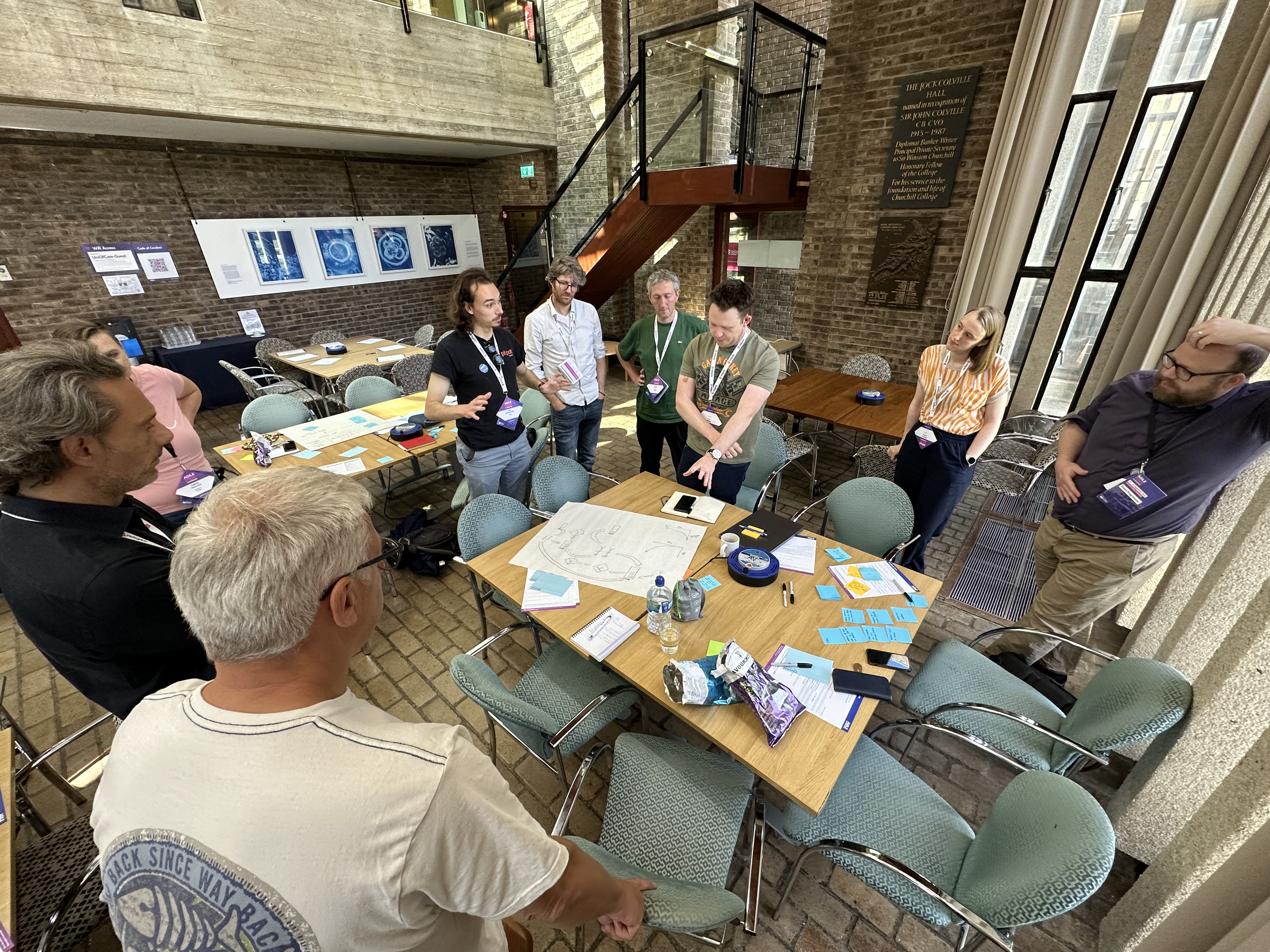
On 29 September, Marc Evers and Willem van den Ende ran the second Stigmergy at Work workshop, at Agile Cambridge 2023. It is part of a series of workshops we run at conference to explore the concept of stigmergy within the context of software development (or work in general). The previous workshop was at Lean Agile Scotland 2023.
Read More
Rob and I ran a workshop at Lean Agile Scotland 2023 on Stigmergy. Two groups thought about how their actions shape their environment, which in turn encourages more actions.
Read More
Where to focus improvement efforts in an organisation is difficult, especially with software and multiple stakeholders. Should we bet the house on technical excellence? Let's look at it through three different feedback loops, to see if we are focusing on the 'right' stuff.
Read MoreProductivity of software development teams is difficult to get a grip on, but virtually everyone wants teams to be more productive. We often talk to managers, who say they’d like their teams to be more productive, or in their words ‘go faster’. Today we write a bit more about what we see around productivity in software development, and how seeing productivity as a property of a system can help you spot symptoms, fire-fighting and work towards more durable solutions.
Read More
“We have no time to improve” is something we hear regularly. Our knee jerk response is the old dutch proverb:
You don’t have time, you make time.
In our experience, improvements pay off faster than people believe, so it is worth making time to improve. See how we use flow distribution to make this visible.
Read More
To get better insights in how a team can grow and what support they need from their organization, we use the Agile Fluency® model and associated tools. In this post, we’ll share how we run an Agile Fluency team diagnostic workshop and how we use systems thinking techniques to arrive at recommendations for both the team and management.
Read More
Today we’re writing about how simple acts improve feedback loops, which has a compounding effect in development teams over time.
Read More
We are fans of Test Driven Development (TDD). It has served us well over the years. The TDD cycle - test, fail, run, refactor - is all about getting rich feedback fast, feedback about design decisions, about the test, about your code. We thrive on fast tests. We also want to test-drive our adapter integration and UI tests. These tend to be slow and fragile with low quality feedback, so we try to keep these minimal.
Read More
Are you regularly holding retrospectives, but they do not result in improvements? In this post we will highlight how a team can move to a virtuous cycle of continuous improvement.
Read More
Imagine your UI and end-to-end tests could run an order of magnitude faster than they are now? Oh, you don’t have end-to-end tests, because they would be too slow and brittle? I have had that too, don’t worry. Imagine then if you could have cost-effective end-to-end tests. How would that impact your product development?
Read More
Working as a consultant, facilitator and coach has taught me the subtle art of not intervening. However simple non-intervening sounds, it is quite difficult to put into practice.
Read More
Where to focus improvement efforts in an organisation is difficult, especially with software and multiple stakeholders. Should we bet the house on technical excellence? Let's look at it through three different feedback loops, to see if we are focusing on the 'right' stuff.
Read MoreProductivity of software development teams is difficult to get a grip on, but virtually everyone wants teams to be more productive. We often talk to managers, who say they’d like their teams to be more productive, or in their words ‘go faster’. Today we write a bit more about what we see around productivity in software development, and how seeing productivity as a property of a system can help you spot symptoms, fire-fighting and work towards more durable solutions.
Read More
“We have no time to improve” is something we hear regularly. Our knee jerk response is the old dutch proverb:
You don’t have time, you make time.
In our experience, improvements pay off faster than people believe, so it is worth making time to improve. See how we use flow distribution to make this visible.
Read More
To get better insights in how a team can grow and what support they need from their organization, we use the Agile Fluency® model and associated tools. In this post, we’ll share how we run an Agile Fluency team diagnostic workshop and how we use systems thinking techniques to arrive at recommendations for both the team and management.
Read More
Today we’re writing about how simple acts improve feedback loops, which has a compounding effect in development teams over time.
Read More
Are you regularly holding retrospectives, but they do not result in improvements? In this post we will highlight how a team can move to a virtuous cycle of continuous improvement.
Read More
Working as a consultant, facilitator and coach has taught me the subtle art of not intervening. However simple non-intervening sounds, it is quite difficult to put into practice.
Read More
Software delivery is knowledge intensive work. We are continuously learning, about the problems we’re solving, about our users and customers, about how we can work more productively. We are building up knowledge in multiple areas, but we are not always good at keeping knowledge or making most use of it. Take working with legacy code for example, which often feels like a process of archaeology, rediscovering long forgotten knowledge.
Read More
Why and when do we introduce a new practice? We see a colleague, friend, and/or influencer telling success stories about it. Eager to get the benefits, we start out experimenting and learn how well it is living up to our expectations. We also start seeing other unanticipated effects — distractions, anomalies? Or learning opportunities? In this post we advocate for embracing unintended consequences.
Read More
People try something in their team, it works great, and then they go out in the world trying to sell everyone on that practice. We’ve done this too when eXtreme Programming worked much better for us than expected in the early 2000s. When such a “best practice” goes out in the wild, it will work for some, but less so for others. So we end up with “Why you should do Test Driven Development (TDD)” versus “TDD does not work” positions.
Read More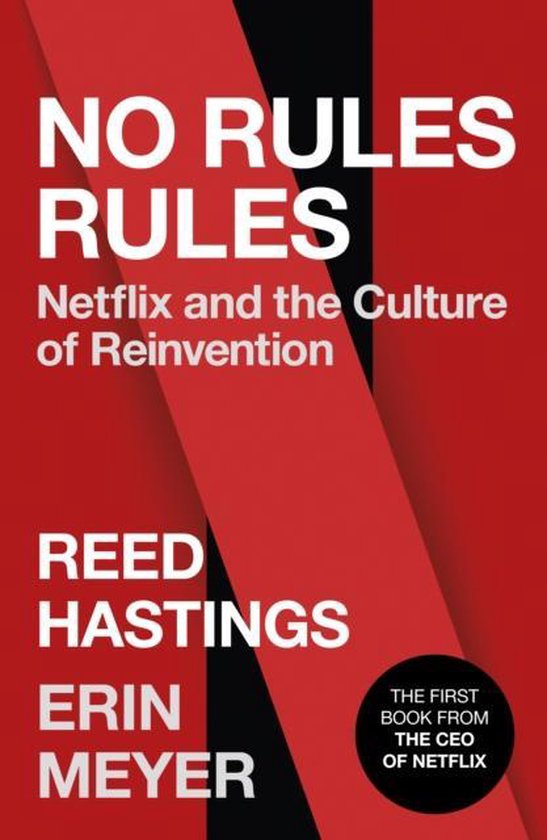
No Rules Rules - Netflix and the Culture of Reinvention by Reed Hastings (Netflix co-founder & CEO) and Erin Meyer
Read More
Are you regularly holding retrospectives, but they do not result in improvements? In this post we will highlight how a team can move to a virtuous cycle of continuous improvement.
Read More
Sallyann Freudenberg once asked how do developers communicate during pair programming. Do you talk, draw, or let the code or tests talk?
Read More
Jez Higgins and Chris Oldwood recommended The Practice of Programming book to me when we were working on an enterprise C++ project. It is from the same vintage as Extreme Programming Explained and Refactoring, but quite different. It is multi-language, but some of the exercises are in C (not surprising, given the authors’ backgrounds). I got started on it last year, but life got in the way, and I needed to practice my C a bit before being able to do anything meaningful in it. Now that Rob and I are prepping for a C++ TDD / Legacy code training next month, I’m in the right frame of mind to also dive deeper into C.

No Rules Rules - Netflix and the Culture of Reinvention by Reed Hastings (Netflix co-founder & CEO) and Erin Meyer
Read More
Read MoreA heuristic is anything that provides a plausible aid or direction in the solution of a problem but is in the final analysis unjustified, incapable of justification, and potentially fallible.

Jez Higgins and Chris Oldwood recommended The Practice of Programming book to me when we were working on an enterprise C++ project. It is from the same vintage as Extreme Programming Explained and Refactoring, but quite different. It is multi-language, but some of the exercises are in C (not surprising, given the authors’ backgrounds). I got started on it last year, but life got in the way, and I needed to practice my C a bit before being able to do anything meaningful in it. Now that Rob and I are prepping for a C++ TDD / Legacy code training next month, I’m in the right frame of mind to also dive deeper into C.

When you are changing an interface or API that is widely used, it can be tempting to do the change in one go and break a lot of tests at once, assuming you can just fix them. You risk ending up chasing failing tests around for hours, with lack of good feedback why they fail. Furthermore, you risk breaking something along the way, because you have created holes in your safety net!
Read More
Read MoreA heuristic is anything that provides a plausible aid or direction in the solution of a problem but is in the final analysis unjustified, incapable of justification, and potentially fallible.

As we spend more time reading code than writing it, we’d like our code to be glanceable. By glancing at the code, we want to quickly understand its intent. Glanceability is a useful property, for production code as well as test code. Test code is there to help us out, so being able to quickly grasp what the test is about will help future us, and others, keep our tests habitable.
Read More
How do I structure my tests, so that they are understandable and focused on the behaviour of the system under test? Given-When-Then and Arrange-Act-Assert are two similar ways of structuring your test cases to make them easier to understand at a glance. This test structure also helps to keep your test focused on a single concern.
Read More
We do not like long test scenarios with loads of different asserts. A test case that has many expectations is difficult to understand when it fails. We then have to dig inside the test’s implementation to see what exactly went wrong where. Before we know it, we fall in to a lengthy debugging session.
Read More
We use test names or test descriptions to tell what the test is about: what is the action or event, what is the expected result.
Read More
Once we have a failing test, how do we get to green quickly? If we can get away with faking it, we do that. It is sometimes the simplest way to get the test to pass, and to remind us to write the next test case.
Read More
When we have written a failing test, we try to make it work in the simplest possible way - do the simplest thing that could possibly work. We prefer baby steps, so at each step we understand precisely what we are doing, even if we have not solved the whole problem yet. Cheating and faking are allowed.
Read More
Where do we start when test-driving a new piece of code? All options are open, but we risk getting stuck because of the blank-piece-of-paper feeling. Because we want to take baby steps towards the end result, use the 0, 1, N guideline: we start with some ‘zero’ or edge case, then make it work for a single case, then generalize it to multiple cases.
Read More
Write the last part of your test first: start with the expectation (or the assert) and write the test bottom-up.
Read More
Write a test based on how you wish the object under test could be used. Then make it work. Don’t let yourself be limited by constraints and implementation details… nothing is holding you back! Just write it as you’d wish it to be.
Read More
When writing a test, we don’t just think about how to formulate the test. We think about design - the design of the code-under-test and the context in which it fits. Writing a test is an act of design.
Read More
User Story Mapping is one of our favourite practices that we often use with clients and in courses. User Story Mapping is an agile product planning practice, with its roots in user centered design. It has been popularized by Jeff Patton.
Read More
Where to focus improvement efforts in an organisation is difficult, especially with software and multiple stakeholders. Should we bet the house on technical excellence? Let's look at it through three different feedback loops, to see if we are focusing on the 'right' stuff.
Read More
To get better insights in how a team can grow and what support they need from their organization, we use the Agile Fluency® model and associated tools. In this post, we’ll share how we run an Agile Fluency team diagnostic workshop and how we use systems thinking techniques to arrive at recommendations for both the team and management.
Read More
Recently we got asked: “How do we (as a development team or larger group) ‘sell’ technical debt to stakeholders?”
Read More
To get better insights in how a team can grow and what support they need from their organization, we use the Agile Fluency® model and associated tools. In this post, we’ll share how we run an Agile Fluency team diagnostic workshop and how we use systems thinking techniques to arrive at recommendations for both the team and management.
Read More
Recently we got asked: “How do we (as a development team or larger group) ‘sell’ technical debt to stakeholders?”
Read More
What’s cooking in QWAN’s kitchen - September 2023.
Read More
Marc and Rob are running a workshop on warmups at XP Days Benelux. It is a workshop to share the ways we warm up for practice. This is what I learnt from drawing warmups.
Read MoreI went on a little road trip the last couple of weeks, running three new sessions and our classic TDD and legacy code course at a long term client. So I have been able to dump some of my brain on people and come out with more rules of thumb and catch phrases that might help to explain how I work at the moment.
Read More
We’ve finally launched our youtube channel! This was only on the to-do list for a decade or so.
Read More
I am running a session at the Swindon Developers meetup this Thursday at 6:30PM *. There are still some places available, so join me and register now. In this session I will demonstrate how we make better decisions by making results of work visible through tools that we built for the questions we have. The title evolved from a discussion with the organiser, Sean Moir.
Read MoreBuilding your own tools is kind of addictive. Once we learn how to make productive tools, it can be hard to stop. There is much to see in a code base. But as we learned from using static analysers to find code smells in the past, you want just enough information for what you are doing right now.
Read MoreSince April, I’ve been experimenting more intensively with augmented code generation, quite often with a clear-ish vision, a pair, tests and other of our favourite engineering practices.
Read More
Wouter Lagerweij and I will be running the eXtreme Vibe Coding session in a one hour slot at XP Days Benelux 2025, in the Kapellerput in Heeze, NL on 27 or 28 November. We will be there for both days, and probably the pre-conference dinner.
Read MoreI accidentally made a local shallow research tool, while learning about Large Language Models. As a small LLM put it: “This tool simplifies your research process, making it more effective and efficient for deep learning”.
Read MoreYou are not meant to read all patterns in a design patterns book. Read the introduction, browse through the patterns in the list - usually at the back of the front cover, Note a few that spark your interest, and read those.
Read More
We are happy to announce that our strategic and tactical DDD teaching case is now publicly available. Although the case description is just over a page, we managed to put domain complexity, ambiguity, and other challenges in there.
Read More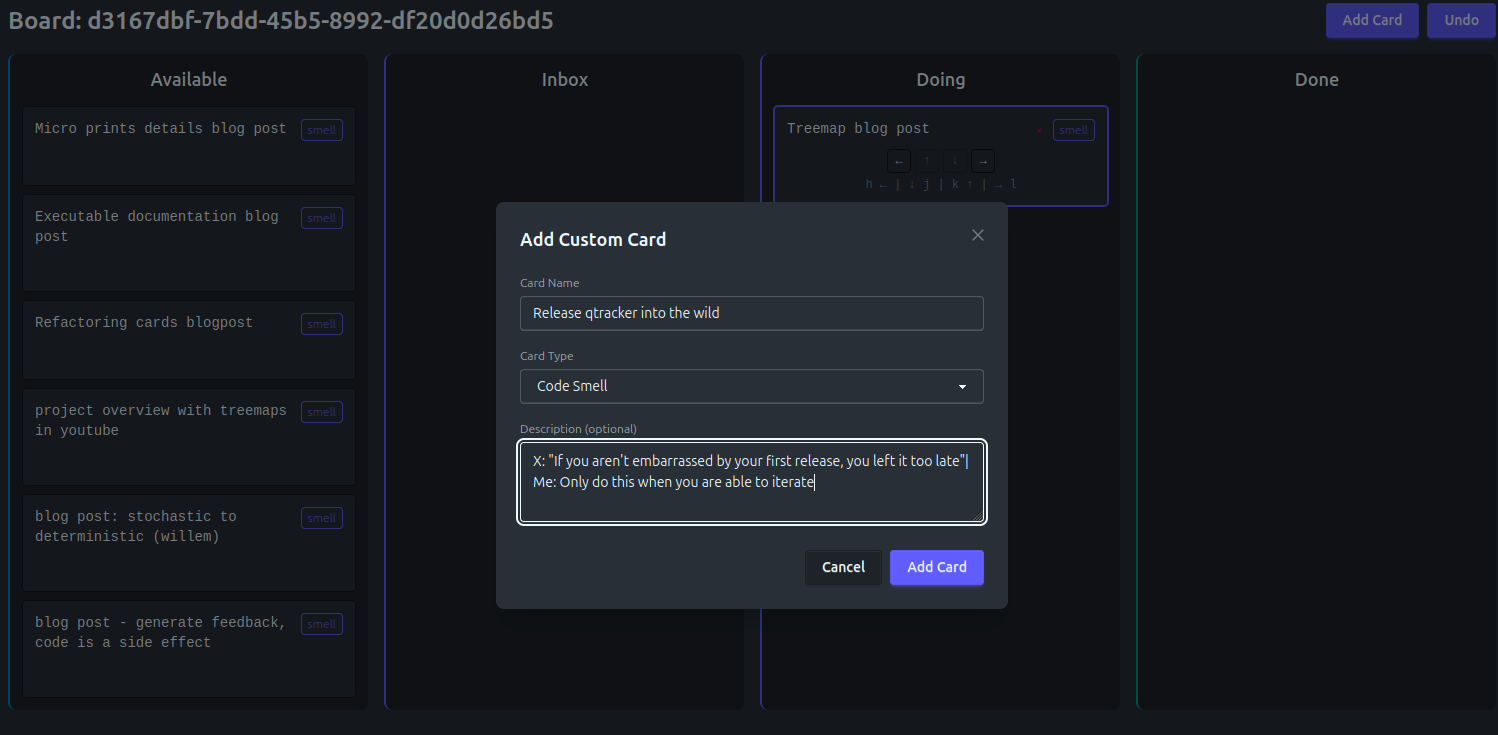
QWAN Tracker is task tracker for small, fast moving teams. For people who do the work, by people who do the work. It lets you quickly jot down things you think need doing as you are working, so you can stay focused on the task at hand. Keyboard navigation, and live sync so your partners stay in the loop.
Read MoreI went on a little road trip the last couple of weeks, running three new sessions and our classic TDD and legacy code course at a long term client. So I have been able to dump some of my brain on people and come out with more rules of thumb and catch phrases that might help to explain how I work at the moment.
Read More
We’ve finally launched our youtube channel! This was only on the to-do list for a decade or so.
Read More
I am running a session at the Swindon Developers meetup this Thursday at 6:30PM *. There are still some places available, so join me and register now. In this session I will demonstrate how we make better decisions by making results of work visible through tools that we built for the questions we have. The title evolved from a discussion with the organiser, Sean Moir.
Read MoreBuilding your own tools is kind of addictive. Once we learn how to make productive tools, it can be hard to stop. There is much to see in a code base. But as we learned from using static analysers to find code smells in the past, you want just enough information for what you are doing right now.
Read MoreSince April, I’ve been experimenting more intensively with augmented code generation, quite often with a clear-ish vision, a pair, tests and other of our favourite engineering practices.
Read More
I am running a session at the Swindon Developers meetup this Thursday at 6:30PM *. There are still some places available, so join me and register now. In this session I will demonstrate how we make better decisions by making results of work visible through tools that we built for the questions we have. The title evolved from a discussion with the organiser, Sean Moir.
Read More
I am running a session at the Swindon Developers meetup this Thursday at 6:30PM *. There are still some places available, so join me and register now. In this session I will demonstrate how we make better decisions by making results of work visible through tools that we built for the questions we have. The title evolved from a discussion with the organiser, Sean Moir.
Read MoreIn Advent(ure) of System Seeing Day 3 we use a Futures wheel to quickly explore consequences of things evolving around our bicycle related topic from the previous days.
Read MoreIt is the 9th of december. The Advent(ure) in System Seeing has been going for a couple of days already, thanks Ruth Malan. I enjoyed last year. I am starting late, I was bootstrapping a SaaS while running three new sessions in 8 days, and then an on-site training course (thanks, regular clients, you know who you are). That all requires a bit of focus, while being good fun.
Read More
QWAN Tracker is task tracker for small, fast moving teams. For people who do the work, by people who do the work. It lets you quickly jot down things you think need doing as you are working, so you can stay focused on the task at hand. Keyboard navigation, and live sync so your partners stay in the loop.
Read More